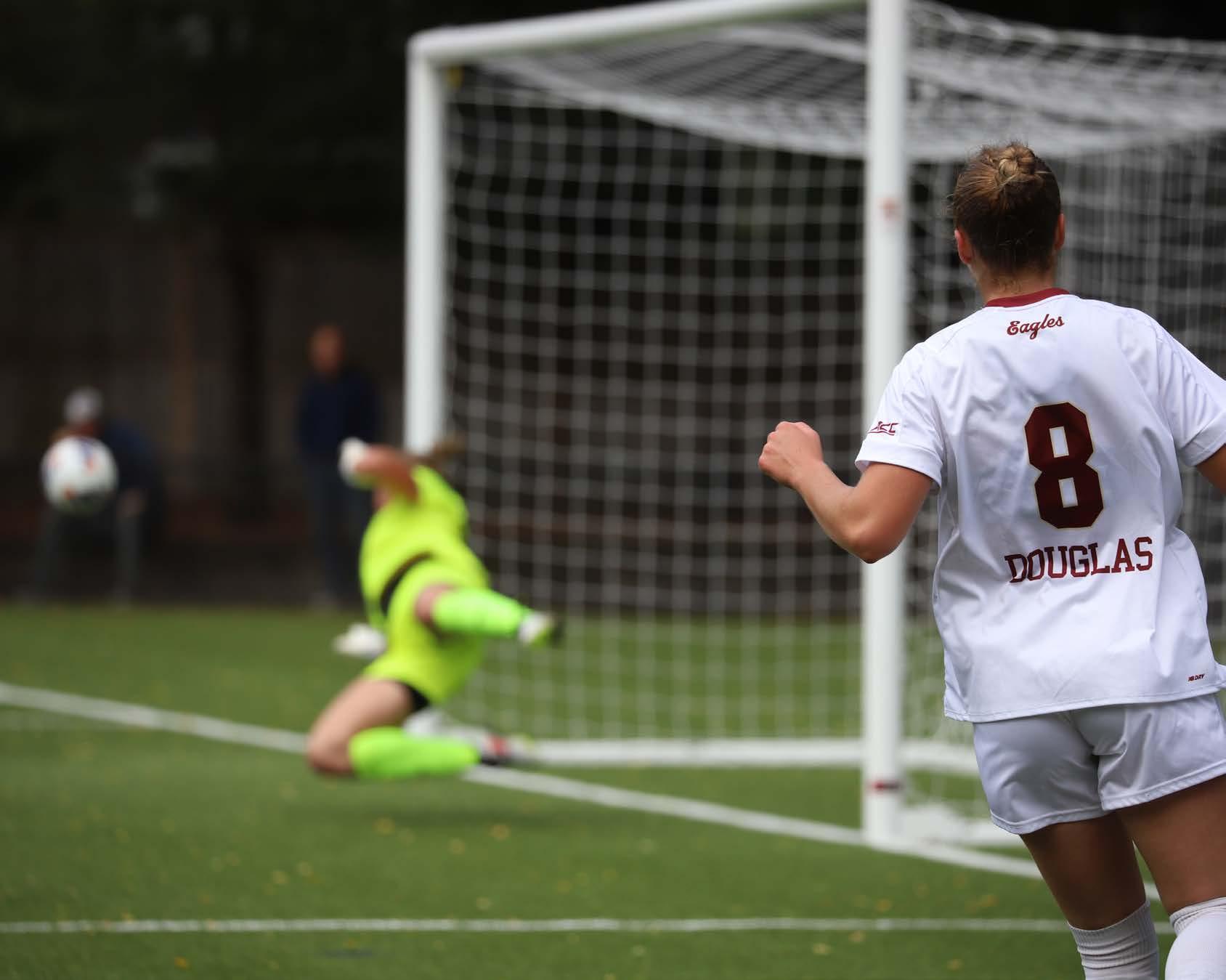
October 7, 2024


October 7, 2024
Through these minors, the department hopes to highlight the interdisciplinary nature of theological studies.
BY REETU AGNIHOTRI
Boston College’s theology department is launching three new minors in partnership with the philosophy department and the Lynch School of Education and Human Development (LSEHD).
“ Te desire is to ofer an opportunity to show how theology can be a discipline that helps students to connect multiple interests,” Chairperson of the Teology Department
Andrea Vicini, S.J., said.
BC theology is introducing mi-
nors in interreligious studies, Catholic education and theology, in conjunction with the LSEHD, and a joint philosophy and theology minor.
“We want to show how theology can enrich their expertise, their competence, and their ability to develop further interests that com-
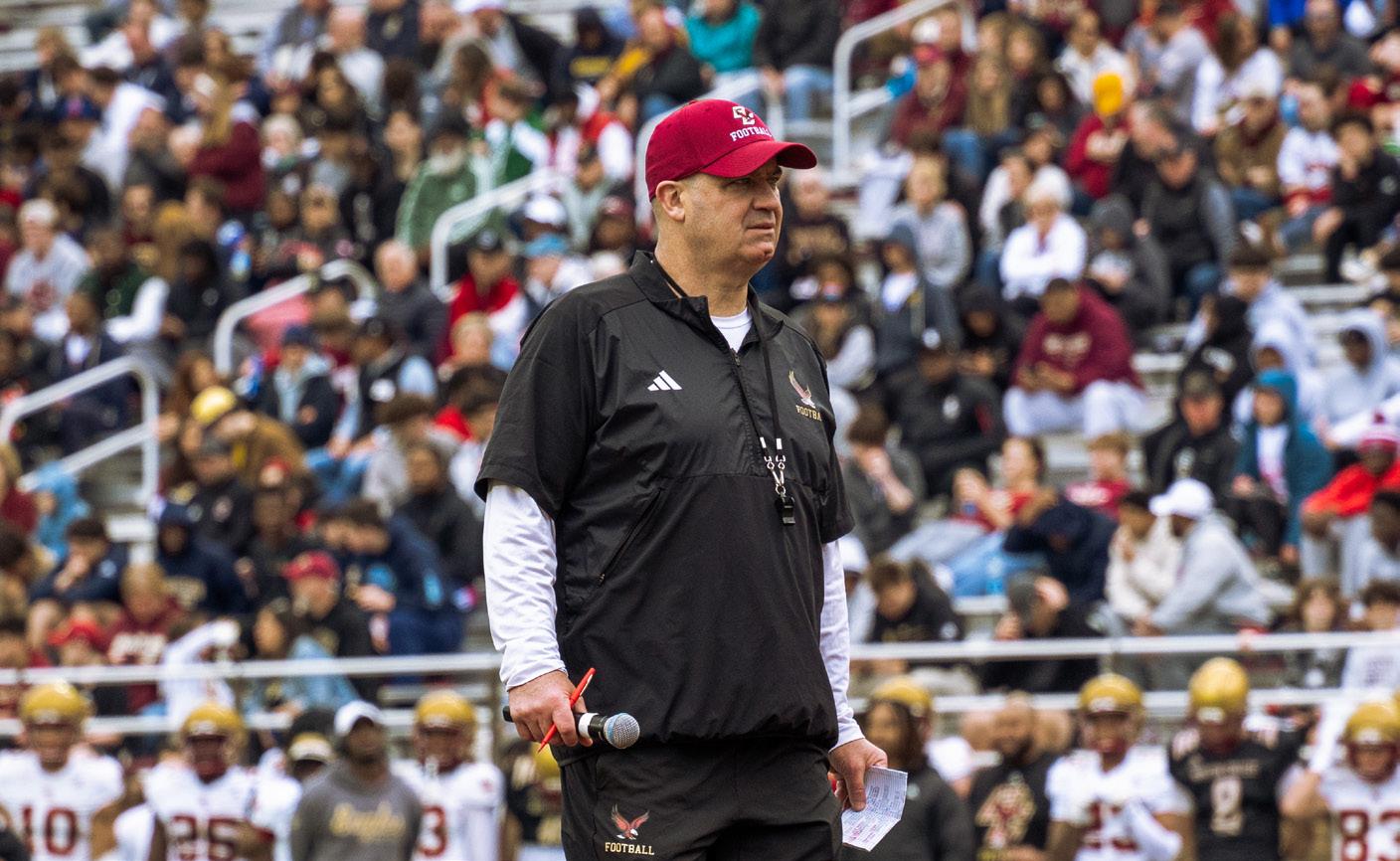
plement the other interests they already have,” Vicini said.
Te theology department created the minors to appeal to students of ranging interests, according to Vicini. Teology can go hand-in-hand with any discipline, and the minors will be avenues for students to explore these interdisciplinary paths.
“There seems to be a student desire or an expansion of the dialogue courses into something that is more practical,” said Director of the Interreligious Studies Minor Natana DeLong-Bas. “How do we engage in interreligious leadership?”
In a 24–14 loss to the C avaliers, the Eagles went scoreless in the second half. See Teology, A2
BY LUKE EVANS Sports Editor
As Boston College football handily went up 14–0 over Virginia with 13:08 left in the second quarter on Saturday afternoon, it appeared as though the Eagles would coast to a 5–1 overall record and a 2–0 ACC record—feats not seen in Chestnut Hill since 2007 and 2008, respectively.
Nearly three full quarters and 24 unanswered points later, the prospect of BC reaching those marks was long gone.
Despite entering halftime with a 14–6 advantage and a guarantee of receiving the ball to open the third quarter, the Eagles’ (4–2, 1–1 Atlantic Coast) ofense proceeded to collapse, while Virginia (4–1, 2–0) chipped away at BC’s lead and eventually took it, ultimately downing the Eagles 24–14.
“Give Virginia credit, they did a great job,” BC head coach Bill O’Brien said after the loss. “We did not do a good job. Tank God we got 12 days before our next game. Maybe we can get some things corrected. Bad—all the way around.”
BC had no issues to start the frst quarter, forcing a quick Virginia punt before getting to work on its opening drive.
With T omas Castellanos back under center, BC cut through Virginia’s defense like butter. Highlighted by a 34-yard pass from Castellanos to Kamari Morales and capped of by a nine-yard touchdown pass to Jaedn Skeete, the Eagles had no trouble driving 78 yards down the feld to take an early advantage with 7:38 left in the frst quarter.
See Football, A9
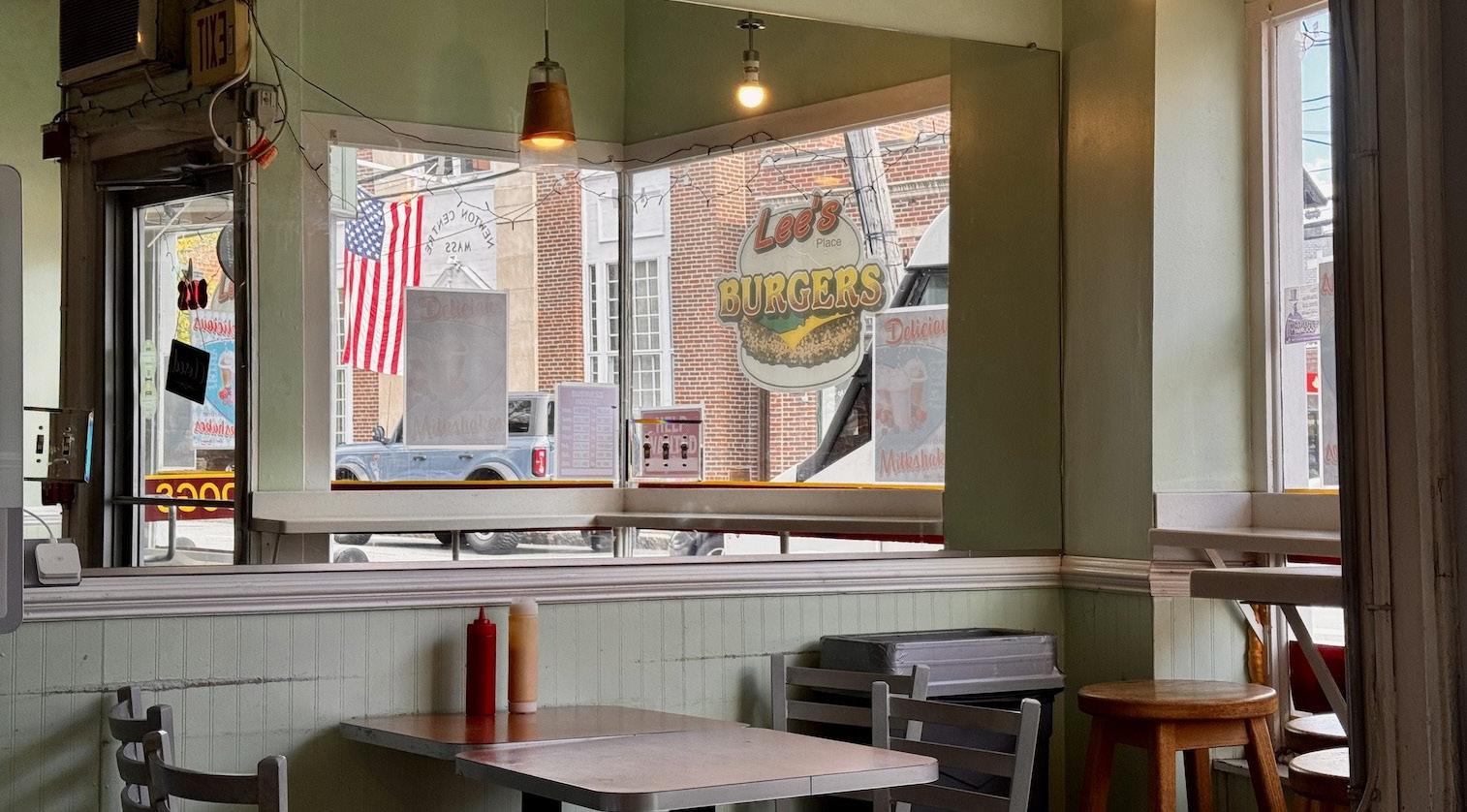
At Lee’s Burger in Newton Centre, the staff serves up indulgent, homey renditions of American staples.
See A4
From a trip to Salem to a stroll through some foliage, Kaylee Dunleavy details diferent ways you can embrace the fall season over the upcoming break.

BY LUKE JACOBELLO Heights Staff
After suffering a 7–1 loss on Friday to 2023–24 NCAA runner-up Wisconsin, Boston College women’s hockey’s Saturday night rematch against the Badgers showed little improvement.
In fact, the second half of the Eagles’ weekend went worse.
The Eagles (1–2) suffered a shutout at the hands of the Badgers (4–0) on Saturday night in Conte Forum. BC netminder Bailey Callaway made her first career start, tallying 54 saves in an attempt to limit the Badgers’ offense.
But the Eagles were outshot 61–13, and the one-sided tilt ended in the Eagles’ first scoreless game of the season.
“They came out stronger than we did,” BC head coach Katie Crowley said after the game. “You can’t give a team like that that many power plays.”
BC came out in the first period eager to avenge its loss from the previous night, and the Eagles came out firing, getting off five shots in the first five minutes.
Callaway made some key saves in the first period to keep things even, tallying two consecutive saves at the 7:53 mark.
Hockey, A10

BY PHOEBE MABUCHI Heights Staff
When Teddy Errico arrived in Telluride, Colo., in 1996 for a six-month internship, he wondered if he had made a terrible mistake.
“When I drove down Main Street Telluride … I looked around and thought to myself how this was the biggest mistake I could ever make,” Errico said. “I’m just in the middle of nowhere, and what am I going to do?”
28 years later, he is now the town’s mayor. Errico, BC ’91, was elected mayor of Telluride, Colo., last November. Te small town of just over 2,500 people is renowned for its world-class ski resorts, summer music festivals, and stunning landscapes. While Errico has lived there for nearly three decades now, his path to Telluride was anything but planned.
After graduating from Boston College with a marketing degree, Errico sold tickets for a professional football team temporarily, until he got a job
with a small advertisement agency in midtown Manhattan.
But he soon decided the advertising business wasn’t for him and quit to enroll in Temple University’s Sports and Recreation Administration program.
In his fnal semester of the program, he was required to complete an internship out in the feld. Having taken classes in travel and tourism, Errico knew the ski resort industry was on the rise, so he decided to seek an internship at a ski resort.
After fruitlessly writing and applying to a laundry list of places, a small ski resort in Colorado gave him an ofer.
“Telluride, being an independently owned, smaller ski resort, was willing to create a program for me because they knew they were getting a pretty educated person to come work for free,” Errico said. “Tey were willing to do that to help me because I would help them.

Opinions
“Your vinyl collection doesn’t make you cool,” writes Senior Staf Tommy Roche, as he unpacks why Generation Z is so attached to pre-2010s technology.
A6
This Week’s Top 3 Events
Refect on the American Constitution and its relevance today at a lecture by professors titled “A Defense of the American Constitution.” The event, co-sponsored by the political science department and the BC John Marshall Project, takes place Monday at 4:30 p.m. in Higgins 310.
Learn about the American origins of white Christian nationalism and its efects on democracy today. Hear
Former Republican Congresswoman Liz Cheney is returning to the Heights for the Council for Women of Boston College’s annual colloquium on Oct. 29, the council announced Tuesday.
Cheney represented Wyoming’s at-large congressional district in the House of Representatives from 2017 to 2023. She also previously served as the chair of the House Republican Conference, the third highest-ranking position in the House Republican leadership, from 2019 to 2021.
Cheney visited BC in the spring of 2023 as part of the Winston Center for Leadership and Ethics’ Clough Colloquium, fielding questions about her vote to impeach former President Donald Trump, the Russian invasion of Ukraine,
and immigration, among others.
Since Cheney’s last time on campus, she has published the New York Times bestselling book, Oath and Honor: A Memoir and a Warning, which “recounts how she helped lead the Select Committee to Investigate the Jan. 6. Attack on the United States Capitol,” according to the New York Times bestsellers list.
Cheney, who recently announced her endorsement of Kamala Harris for president, will be attending the colloquium one week before the 2024 U.S. Elections on Nov. 5.
BC Law Dean Odette Lienau will moderate the colloquium.
Lienau’s research and teaching interests center around international economic law, international law and relations, and political and legal theory, according to the announcement. n

DeLong-Bas said religion is often depicted as a factor of confict in the news but that she hopes the interreligious studies minor will teach students about other ways in which religious communities can engage with one another productively in support of common goals.
“I’m hoping that the minor will help students to become more aware of a lot of the good work that’s already done at the community level and will hopefully inspire their creativity and
thinking about how they want to engage areas of con f ict moving forward,” DeLong-Bas said.
The interreligious studies minor begins with a “dialogue course,” which examine the relationship between Christianity and other religions. Te next step will be a new course on engaging interreligious leadership, in which students will read case studies. To round out the minor, there will be four additional electives that students can take on religious traditions of their choosing, DeLong-Bas said.
“ Tere’s a lot of choice for students, so they can really tailor the minor to their particular interests, but come out of it with a broad framework that should be helpful to them and work well with really any major,” DeLong-Bas said.
Te interreligious studies minor aims to train students in methods of dialogue that will carry over into many diferent career felds.
The new theology and philosophy minor strives to achieve this interdisciplinary engagement as well, according to Jason Donnelly, director of the minor.

“We are looking to provide another avenue for students to explore the relationship between philosophy and theology, but more intentionally, where they overlap,” Donnelly said.
T e theology and philosophy minor follows much interest from students in perspectives on Western culture, a frst-year course that teaches both theology and philosophy. Te minor was created with hopes to not only expand that curiosity but to entice more students to explore theology, Donnelly said.
“ Te more opportunities there are for students to explore theology, the better,” Donnelly said.
Students will have the freedom to choose the rest of their elective courses, only being required to take three philosophy and three theology courses total, Donnelly said.
“ Te theology and philosophy minor will comprise of existing courses, two philosophies and two theologies, then allowing for fexibility in scheduling,” Donnelly said.
Charles Cownie, director of the Urban Catholic Teacher Corps, will co-direct the new Catholic education and theology minor, which Donnelly said was introduced for individuals of any major who are interested in Catholic education as an area of study or as a potential career.
“I think there’s a great desire to do a lot in Jesuit education and Catholic education at the graduate
level,” Donnelly said. “But the right fit and the right opportunity I don’t think existed previously for undergraduate students.”
Liam Bergin, co-director of the Catholic education and theology minor, said the minor was created not only to accommodate interests of students in the LSEHD, but because BC is an institution that is always encouraging and thrives of the collaboration between departments and subjects.
“We want majors from across all subject areas that want to have more of the theology and Catholic [education] experience, to better understand their educational experience and why it was the way it was,” Cownie said.
The Catholic education and theology minor will follow a curriculum including three classes from the theology department and three from LSEHD, immersing students in the teaching atmosphere as well as giving a thorough background of theological studies.
With the new minors, BC theology hopes to create opportunities for students to develop their interests with the introductory courses and advanced electives, Vicini said.
“We build on the expertise of our department and are open to the possibility of collaborations, interactions, and for the students to see how these minors are related to what we offer,” Vicini said. n
that it is not an accident that the current attempt to overthrow democracy presents itself as an attack on American women, because American women created the modern American state,” Richardson said.
Heather Cox Richardson believes women’s participation in democracy is more important now than ever before.
“If there’s one thing that strikes me about this moment, it is both the truly extraordinary misogyny of this moment and the extraordinary eforts of American women to take up a place in American society and turn back that misogyny in the attacks on American democracy,” said Richardson, professor of history at Boston College.
Students and community members filled the Heights Room on Tuesday afternoon to hear Richardson share her perspective on the American government in an event named after her best-selling novel, Democracy Awakening: Notes on the State of America Richardson said she believes American democracy is in danger, especially for women.
“I would like to suggest today
An expert on Western American history, Richardson highlighted misconceptions about the historical role of women in the American West and how their stories refect a national underappreciation of women’s infuence.
Te real American West was centered around women,” Richardson said. “It was a West of political reform, and it was one that focused on norms, rules, and education.”
Richardson also emphasized how, contrary to popular belief, American civic life has always relied on the contributions of minorities.
“American mythology had always privileged white men, but the country had never functioned without the full participation of everyone in the community,” Richardson said. Richardson added that promoting community-based politics is central to solving some of the problems the United States faces, citing the
Harris-Walz campaign’s rhetoric at the Democratic National Convention as an example.
“You saw Vice President Harris at that convention reject the identity politics for which the Democrats have been known for since at least the 1970s and instead embrace community,” Richardson said. “She talked about community—often a female-based community.”
Richardson contrasted Kamala
Harris and Tim Walz’s community-based campaign with the authoritarian approach taken by Republicans.
“Within America we are choosing between two visions of government now,” Richardson said. “One based on an old concept of government, based on economic relationships that a few men can dominate, or, on the other hand, a concept of government based in the reality of a community in which all of us have lived but not recognized in our government,” she said.
With just fve weeks until the 2024 presidential election, Richardson encouraged the American people to recognize the power of the female vote.
“I really don’t see how you look at where we are in the United States today and not see the centrality of women’s participation in government as central to how things are going to come out,” Richardson said. n

BY JACK BECKMAN Asst. News Editor
When asked about recent of-campus break-ins and suspicious activity incidents, Assistant Dean for Of-Campus Student Life and Community Engagement Peter Kwiatek stressed that Brighton is among the safest neighborhoods in Boston, with low violent crime rates.
In many break-ins, students left windows or doors unlocked, ofering easy access to their homes, Kwiatek said at the UGBC Senate meeting Tuesday.
“ Te police talk about, ‘ Tere’s no break-ins, there’s just entering,’ because frequently the properties [burglars] are going into are just open—doors are open, windows are open,” Kwiatek said.
Kwiatek and Corey Kelly, associate vice president and dean of
students, visited the UGBC Senate to feld questions from student senators and explain the goals and responsibilities of the Ofce of the Dean of Students (DOS).
Boston College pays the Boston Police Department (BPD) over $100,000 each academic year to patrol off-campus neighborhoods every Tursday, Friday, and Saturday night, according to Kwiatek and Kelly. When crimes occur, BPD details additional patrols to the area, they added.
T e police response is really impressive, and sometimes it’s not all that visible because they know if a cruiser is parked out front, someone’s probably not going to try it again, so they often work in an unmarked car,” Kelly said.
Kelly and Kwiatek said students in recent years have been more proactive in calling the police immediately after suspicious activity or break-ins
occur—a shift that has led to more suspects being arrested.
“I can think of several instances recently where the police have caught the suspect, which is huge and didn’t used to happen,” Kelly said. “I’ve been here almost 12 years, and I think that’s a shifting trend. I think students are doing a really good job of being proactive and looking out for themselves.”
Kwiatek also highlighted how his ofce aims to support students navigating of-campus life by maintaining a database of available of -campus listings, helping resolve landlord disputes, and fnding subtenants.
“We do a lot of things to help those students of campus feel like they’re not forgotten,” Kwiatek said.
Tey are on top of our mind, and we’re trying to think specifcally for them so that they have a robust student experience.”
When BC students think of the Ofce of the Dean Students (DOS), conduct hearings and sanctions often come to mind, Kwiatek said—but it doesn’t have to be that way, he emphasized.
“We are a central hub for care and support for students—no matter the issue,” Kwiatek said. “Tings come to us that are very complicated, that don’t ft into one bucket … and our o f ce is kind of the holder of that as we help students navigate their journey here.”
Te DOS is comprised of four primary areas—student conduct, student support, disability services, and off-campus life, according to Kelly and Kwiatek.
“We really try our best to be proactive, to get in front of students, to help educate, inform, to hopefully prevent things from happening,” Kwiatek said.
As an example, he cited how the deans go from door to door reminding students of expectations in the leadup to weekends when many students host parties, such as Hallo-weekend or home football games. Kelly said that while BC students often have high expectations and lofty goals, her ofce seeks to remind them that setbacks and struggles are normal during college, noting that the DOS case managers’ primary job is to support students through stressful situations and mental health struggles.
“A big part of what we do in our ofce is quite literally just normalize struggle,” Kelly said.
After the DOS presentation, the Senate voted to confrm Maaz Shaikh, Messina ’26, as the inaugural Messina College special interest representative and Reagan Marino, MCAS ’26, to the vacant Class of 2026 student seat. n
BY JAKE JANSEN Heights Staff
For Stafford Sheehan, co-founder of Air Company, harnessing science is his company’s greatest asset.
“Our pitch to our biggest customer right now is being able to produce fuel from literally just the air,” Sheehan said.
Sheehan, BC ’11, gave the keynote address at the annual Solstice Entrepreneurship Conference hosted by Start@Shea on Saturday. He discussed his entrepreneurial journey from Boston College to co-founding Air Company and running a successful business while working to negate global carbon emissions.
Air Company now engineers “scalable, modular technology that helps industries reduce greenhouse gas emissions,” transforming carbon dioxide into fuel, according to its website.
After graduating from BC with a degree in mathematics and chemistry, Sheehan set of to New Haven to attend graduate school at Yale.
“I did research in a lab here, and that led me to do research in a lab at Yale,” Sheehan said. “So one thing led to another and I decided to take this path of running businesses rather than an academic
path of being a professor somewhere.”
Sheehan said that he experimented with creating a company during his time at Yale.
“I started out by spinning a company out of Yale,” Sheehan said.
“I kind of cut my teeth with that a little bit.”
While the company now works to solve climate change by addressing major issues like creating sustainable aviation fuel, its initial line of products were much diferent.
“We started out with vodka and perfume as products,” Sheehan said.
Sheehan said his company’s selling point was the environmental friendliness of its products in comparison to its competitors.
Te ethyl alcohol, the ethanol in that is made from carbon dioxide which is captured from the air,” Sheehan said. “So that’s kind of the sales pitch for a lot of our early products.”
An important part of Sheehan’s business philosophy is not only working to mitigate climate change but also to create value for their customers, he said. Tat value can come in many forms.
“For our work with the U.S. military, we reduce fuel supply chain risk by producing fuel on site,” Sheehan said. “So that means you don’t have to get diesel fuel,
jet fuel, gasoline, into a contested environment.”
Now, one of the major focuses of the company is creating more sustainable aviation fuels.
According to Our World in Data, the aviation industry currently accounts for 2.5 percent of global carbon dioxide emissions—and the fgure is only growing.
While some f oat the possibility of using powerful batteries to fuel planes, Sheehan said this is unrealistic, as the required batteries are too heavy. Additionally, jet fuel cannot be easily replaced with batteries, unlike other forms of fuel
like diesel.
“[Jet fuel] is a very specifc type of fuel with a very specifc formulation,” Sheehan said. “ Tat’s where energy density and the amount of energy you have in a gallon of fuel is really important.”
The continued success of Air Company could have major impacts on a global scale, Sheehan said.
“Ultimately, we could address 10 percent of global CO2 emissions,” Sheehan said. “So if you look at a bunch of diferent studies of where greenhouse gas emissions come from and why you need to de-
carbonize certain industries, really, what we could address is around 10 percent of global greenhouse gas. Tat’s really our, I would say, North Star.” But despite Air Company’s work thus far, Sheehan believes that dealing with those emissions will require a larger efort.
“You know it’s not going to be just Air Company,” Sheehan said. “ Tere are going to be many companies in this industry that are going to come together to try to tackle that. Tere’s no silver bullet for a lot of these things. Tere’s no single source.” n
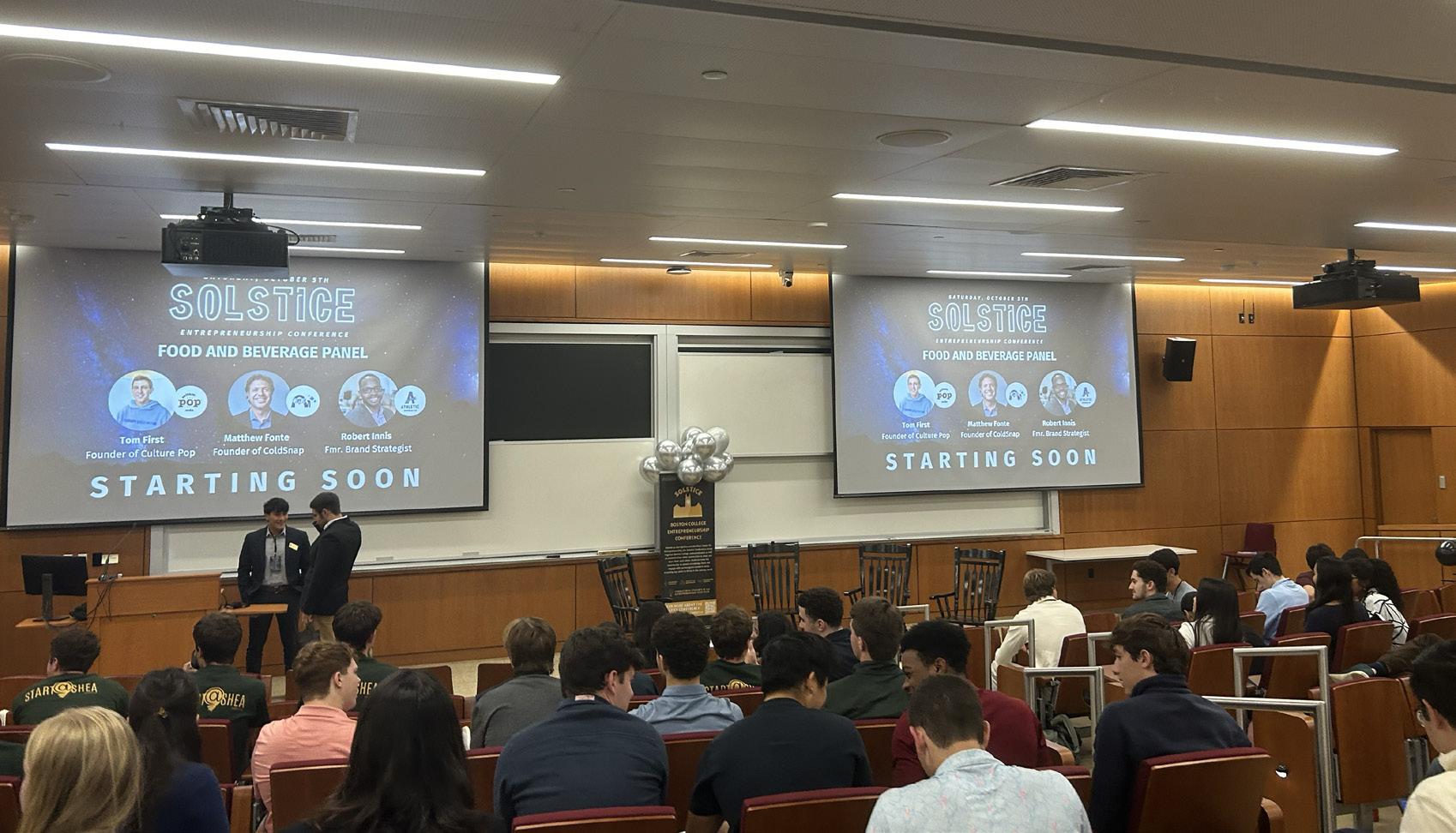
BY ETHAN AMBROSE
For The Heights
NIKITA OSADCHIY
For The Heights
State-sponsored abductions and political imprisonments remain serious violations of human rights warranting accountability, said TaeUng Baik, former director of the Center for Korean Studies at the University of Hawaii.
“Without protecting human
rights, without re-establishing the human rights system, there is no peace—no permanent peace—and sound democracy possible at all,” Baik said.
Boston College’s Global Korea Project hosted Baik on Thursday to discuss his work with the United Nations (U.N.) and his advocacy for domestic implementation of the International Convention for the Protection of All Persons from Enforced Disappearance, a treaty fo-
cused on preventing state-sponsored abductions.
Baik, who served as the chair-rapporteur of the United Nations Human Rights Council Working Group on Enforced or Involuntary Disappearances (WGEID) from 2020 to 2021, detailed how his work with the U.N. is able to foster transitional justice.
Transitional justice refers to a process by which governments provide political redress, reparations,

and reconciliation to victims of human rights violations, according to the U.N.
“We ensure the documentation, and we report to the Human Rights Council and U.N. General Assembly,” Baik said. “We monitor the state compliances, sometimes by ofcial country visits.”
Te U.N. uses a two-tier system when assisting families of enforced disappearance victims, Baik explained, categorizing cases as either urgent or standard procedure.
A case falls under urgent procedure if the disappearance occurred within three months of being reported, prompting the U.N. to immediately contact the involved country. Cases reported after this three-month period are categorized as standard procedures handled by communicating with the host country on a case-by-case basis.
On a U.N.-sanctioned visit to Sri Lanka in 2015, Baik, a then-member of the WGEID, encountered families of individuals who went missing during the Sri Lankan Civil War that concluded in 2009.
“We met eight victims, many of those family members got the frst information interview, and that lady came to us [and] told me that she saw her husband being taken by a policeman in his town, in her town,”
Baik said. “Tat policeman came to her saying that, ‘I know you are going to meet with the U.N. people, and you have two kids still, and they are in school. Be careful.’ Hearing the kind of threats she came still to meet with us, so you see how terrifying the situation [was]. But that is not isolated.”
Prior to his work with the U.N., Baik was a political prisoner of the South Korean government due to his afliations with the South Korean Socialist Workers’ Alliance. According to Amnesty International, he was a prisoner of conscience, arrested for his political afliation and beliefs, and held under interrogation for 22 days.
“When I was imprisoned, we were tortured,” Baik said. “I was tortured.”
Regardless of his imprisonment, Baik emphasized that he does not consider himself a victim of human rights violations, but rather a fghter.
“People considered me as a victim of human rights violation, but I have never felt that I was a victim,” Baik said. “And before fghting for democracy, they never appeared themselves as a victim. Whether they are prison fghters, they want to transform the society, the whole society.” n
BY LIAM DAVENPORT
For The Heights ANDREW NESTER
For The Heights
Situated right in the core of Newton Centre, Lee’s Burger offers indulgent, homey renditions of the American staple.
With locations in Newton and Brookline, Lee’s Burger serves a selection of American classics, including sandwiches, milkshakes, Philly cheesesteaks, and, of course, burgers.
“We love it!” said frequent Lee’s Burger customer Kelcey. “It’s fresh, high-quality, and delicious.”
Jimmy Wong, the owner of Lee’s Burger, immigrated from China four decades ago. Wong worked in the original Lee’s Burger—then called Lee’s Place—after he lost his job at an IT company.
The restaurant eventually moved from Harvard Square to Newton after Wong purchased it from its previous owner in 2013.
Later, Wong decided to
expand, opening a brand-new Lee’s Burger location in Brookline.
Just 15 minutes away from the original spot, the second location still upholds the local business’ culture and traditions.
Now, he is considering further expansion of his business into new areas and locations, or even starting a diferent type of restaurant that would serve food other than burgers.
“I have a very good team of people who are treating each other just like family,” Wong said. “It’s become not like a business but more like a daily life with friends and family. I think that’s most rewarding.”
Lee’s signature burger, aptly titled the “LEE Burger,” features two 6-oz patties, bacon strips, fried egg, and waffle fries all stacked together to form a messy, rich dining experience that’s anything but subtle.
Indeed, top-quality food is a fundamental part of Lee’s Burger.
“If [there’s] anything you’d not eat yourself, don’t serve,”
Wong said. “ Tat’s a very simple rule here.”
Te Newton location, though rather cramped, is a favorite among locals.
“Best onion rings I’ve ever had,” Doug said, a customer at Lee’s Burger.
Positive exchanges with the customers are a signifcant aspect of Lee’s Burger’s culture, keeping people coming back again and again.
“We have a lot of interaction with the customers,” employee Wing Kwan said. “And it’s fun—we get to know the customers and talk.”
Kwan explained that many of their customers are kids stopping by for a quick afterschool meal. With its simple and modest ambiance, the restaurant is reminiscent of an old, worn-out diner that appeals to people of all ages.
“If you’re craving a fast-foodstyle burger, to the max, this is the place to go,” customer David said.
Lee’s Burger’s approach to running the business and serving customers is quite simple and straightforward. “Customers come in because
they just want a burger,” Wong said. “And then, what we are doing here is [serving] the customer.” Lee’s Burger has been consistently involved in local activities and events, showing its connection to the community.
The restaurant annually partners with Boston College for the early fall welcome-back event, Taste of Of-Campus, where ofcampus restaurants provide food samples and coupons for students to explore.
“We are lucky we have lots of support from the local people,” Wong said. n

BY GENEVIEVE MORRISON
Assoc. Newton Editor
Amy Mah Sangiolo and Vlad “Steve” Yanovsky, candidates for the 11th Middlesex district representative seat, faced of Tuesday in a debate hosted by the Charles River Regional Chamber.
Sangiolo is the Democratic nominee, having defeated Alexander Jablon in the Sept. 5 primary. Yanovsky, meanwhile, ran unopposed in the Republican primary.
Te winner of the Nov. 5 general election will succeed Democrat Kay Khan, who’s held the district seat since 1995 and will retire at the end of the year.
The 11th district consists of parts of Wards 1, 2, 3, 4, and 7 in Newton.
Here are some highlights from Tuesday’s debate.
The moderator, Max Woolf, asked both candidates how their life experiences have shaped their political views.
Yanovsky said his experiences both serving in the military and owning a small business have convinced him that the proper role of government should be limited.
“Government doesn’t truly contribute anything to the growth of the economy under any circumstances except limiting private enterprise from generating more revenue and employment opportunities for others,” Yanovsky said. “I think that particular segment of our existence needs to be curtailed and private enterprise needs to be expanded.”
Sangiolo said when she was younger, she had to advocate on behalf of her mother, a Japanese immigrant who spoke little English at the time. She said this experience shaped a belief that the government should support all its citizens.
“I’ve always served as an advocate, not just for my parents, but also for myself,” Sangiolo said. “Later in life, I became an advocate, whether it was for the environment, whether it was for immigrants, people with disabilities, and now people who are facing homelessness because of eviction or foreclosure.”
Housing
Woolf asked Yanovsky what, if anything, he would do to make housing more affordable in the district. Te average price of a single-family home in Newton is $1.6 million.
Yanovsky said he doesn’t think there is a shortage of housing in the district, and he doesn’t think subsidized housing would be good for the community.
“Housing projects, we have tried that before,” Yanovsky said. “It doesn’t work under any circumstances. We’ve tried many things, [like] Section Eight housing, I mean, there’s no investment of the person into the community or into the home that they’re living in.”
Yanovsky recommended that people who can’t afford Newton prices should move somewhere else.
“People should live where they can aford to live,” Yanovsky said. “We cannot transplant people from one community into another and make them part of our community”
Sangiolo said Newton does need more housing stock. To address the issue, Sangiolo said the state should look into tactics like workforce housing, an option to subsidize housing for people who make too much money to qualify for traditional afordable housing, but who still can’t aford market rents.
“We need to increase supply of housing at all income levels,” Sangiolo said. “In particular, my focus has always been about being
more intentional about the deeply afordable housing needs that are out there, as well as middle income and workforce housing.”
Te T Te moderator asked how each candidate would tackle the lack of funding for the redesign of Newton’s T stations, which are currently only accessible by stairs and therefore noncompliant with the Americans with Disabilities Act.
Yanovsky said he would look to fund MBTA reforms with private donations.
“If it were possible to have more community involvement and for people who support the enterprise to help improve the infrastructure by private donations, if that were a possibility, I think that would be a better way to go,” Yanovsky said.
“That would also provide people agency in how these operations are run in their communities.”
Sangiolo said she would put pressure on the state and federal governments to get funding for the Newton station redesigns.
“The more pressure that we can put on our state and federal government to fund these stations, the better, so I’ll be there to advocate and fght for it,” Sangiolo said. “I’m
really ticked of about that.” Ballot Question Candidates were asked whether they support Massachusetts Ballot Question 5, which would require tipped-wage workers to be paid the state minimum wage instead of their current rate of $6.75 an hour.
Sangiolo said she supports the minimum wage for these workers, though she mentioned the state should keep an eye out for complaints of wage theft by tipped-wage workers if the question passes.
“I think that we owe it to our earners, particularly our tippedwage earners that are usually folks that are at the lower earnings spectrum,” Sangiolo said. “We owe it to them to ensure that they get at least the minimum wage.”
Yanovsky said he will vote against the question because he thinks all minimum wage requirements harm the businesses required to implement them.
“I don’t support minimum wage for anything,” Yanovsky said. “It’s going to destroy businesses, destroy restaurants, and it’s going to destroy anyone’s ability to go out and eat in a restaurant, because the prices on food and services are going to be exorbitant.” n
BY MEI DASGUPTA For The Heights
Newton’s Angier Elementary School received a National Blue Ribbon Award from the U.S. Department of Education, one of nine schools in Massachusetts to earn the honor this year.
According to the Department of Education, a National Blue Ribbon awarded school displays exemplary teaching and learning practices that serve as models for education across the nation.
Orla Higgins Averill, principal of Angier Elementary since 2020, emphasized the role of a solid and supportive environment in achieving this feat.
“Te culture of the school is very strong, warm, collaborative,”
Higgins Averill said. “Very real.”
Higgins Averill implemented the Multi-Tiered Systems of Support framework in Angier in an efort to meet each student where they are academically, socially, and emotionally. Te framework is designed to support schools by
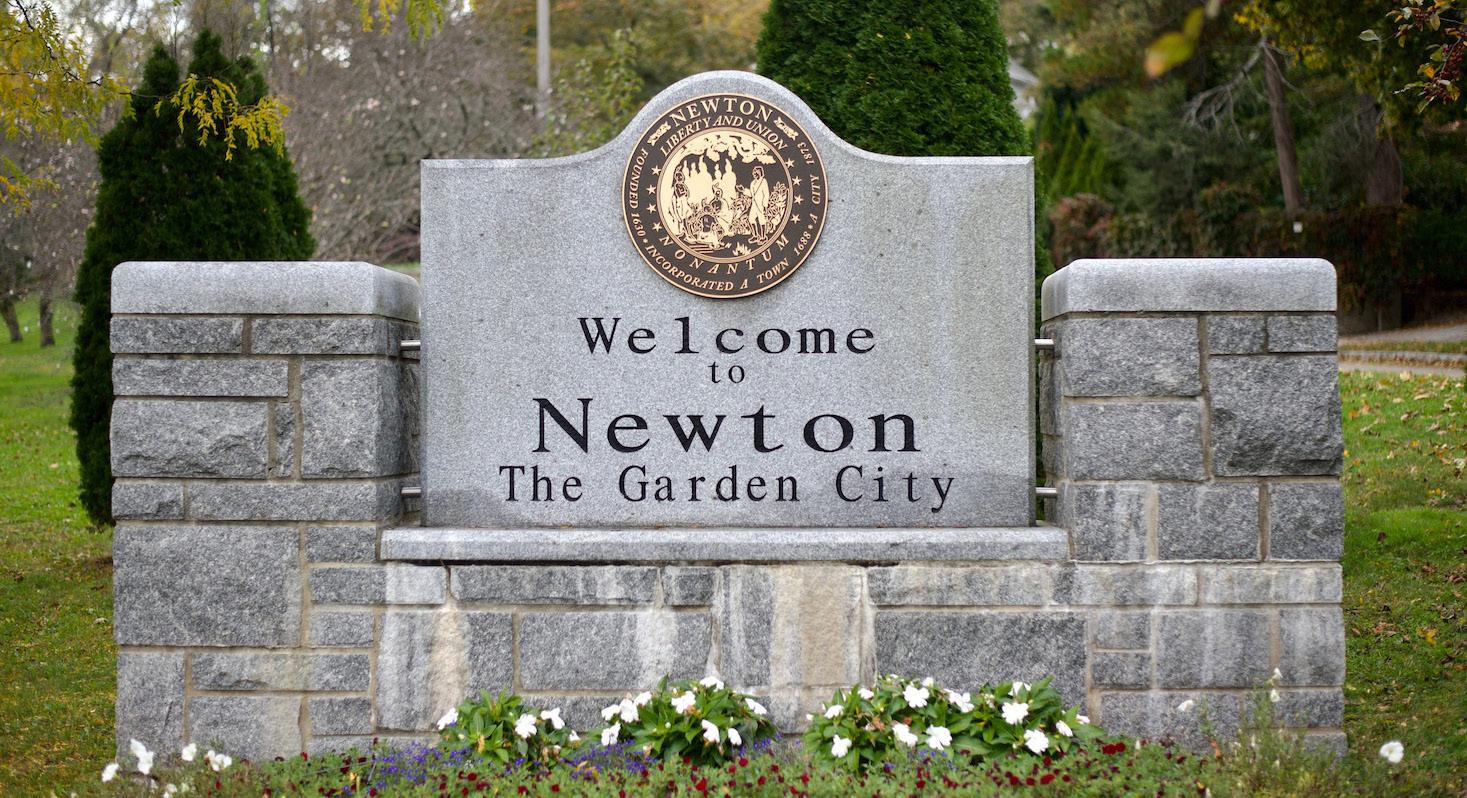
identifying students’ strengths and needs and the appropriate strategies for student growth.
“It’s a model where every student gets what they need,” Higgins Averill said. “We are constantly looking at student data weekly. The structure has been adapted over the last number of years with the input of everyone.”
Edra Wigder, a teacher at Angier for 22 years, explained that the support of both the administration and the parent community is pivotal to creating a place where teachers feel free to take risks and have difficult conversations.
“[Our work] goes hand-inhand with our leadership and the parent community—we have a lot of support around teaching and trust from the parent community,” Wigder said.
Higgins Averill afrmed this sentiment, noting that a cared-for teaching staf is vital to a healthy learning community for everyone.
“In the absence of a culture
where teachers feel safe and cared for, that work would not take root the way that it has here,” Higgins Averill said. “Te teachers at Angier are incredible. It’s really important that school culture and structures support teachers to do their best work in service of students.”
Brigid Tobin, mother of three current students at Angier and copresident of the Angier PTO, said Angier has uniquely impacted her children.
“When we came in [to Angier], Brendan was behind in reading … they immediately fagged that, and his reading specialist and primary teacher caught Brendan up within the year,” Tobin said.
Tobin explained that Angier gladly adopted the necessary technology for her other children, showing the school to be both technology-forward and adaptive to students’ needs.
“My other two boys have hearing loss, and they both are on IEPs, and [Angier has] really embraced using technology,” Tobin
said. “All the teachers wear the microphones—there was never a question of ‘Oh, this is too complicated.’”
Tobin expressed her gratitude for the teachers who make Angier a safe learning environment.
“Tey went out of their way to make students feel confdent,” Tobin said.
Widger said Angier’s special community is what sets it apart from other schools.
“I have been here my whole career, and I can’t imagine myself going anywhere else,” Wigder said. “It’s a special, special place.”
According to Tobin, the unique community at Angier had always been evident, even before receiving the National Blue Ribbon Award.
“We didn’t need the honor to let us know how special the school was,” Tobin said. “You feel it walking the hallways, from the teachers and staff, the janitors and lunch lady, really everyone that orbits the school.” n
The internship consisted of a little bit of everything, Errico said—his responsibilities ranged from advertising, working with sponsorships, and international market research to event planning and producing music events.
The program ultimately landed him a new full-time job at the resort as well as a new home in Telluride.
“Whether someone was 60 years old or 25 years old, we were all friends because we all did the same things,” Errico said. “We play hockey here, we play softball here, we play golf here, and people enjoy the good life. Everyone just had a different pace of life than I was used to, and I got absorbed into that pretty quickly and loved every second of it.”
Errico ran the events department of the ski resort for two years before eventually realizing he wanted a job that would integrate him into the Telluride community more.
He went on to run the local theater for two years until the organization’s owner invited Errico to be his business partner in real estate.
“I always empower it to anybody in life, at any age … that if you work hard and you're genuine, people will look out for you and people want to help,” Errico said. “Without my old boss to introduce me to the new real estate boss … and basically force him to hire me, I wouldn't be in this position today.”
Getting involved in the Telluride community mattered to Errico as he began integrating himself. He worked as a coach for the youth hockey program, a volunteer for the local art and music organizations, and served as an elected member of the Parks and Recreation Commission—a position that gave him his first taste of Telluride’s government.
“I was able to be a part of that organization and what that did was, kind of, you know, opened my eyes up a little bit to how the government functions, what the government's like,” Errico said. “And, to be honest, it opened up some unfavorable opinions of how our town was being run.”
It was those unfavorable opinions, coupled with his love for the community, that led him to run for mayor in September of 2023.
“I like to tell everyone, even as I'm mayor, that I generally hate politics, and I generally hate meetings, so I decided to run for mayor,” Errico said. “But I love my community, and although I might not be the person that everyone thinks has the answer, I generally thought I could do a better job and leave Telluride a better place than when I found it, and so I ran.”
Errico won the election by 10 votes and began his term in November.
His first goal, he said, was to listen—to the community, his staff, council members, and sub-commissions—to get a full sense of the issues the town faced.
“I like to tell people, even now, that just because I was elected,

that didn't all of a sudden make me smarter, and that I have a lot of learning to do,” Errico said.
This listening period went on longer than he expected though— Errico had to learn other people’s perspectives and what was expected of him, he said. But now that he has a grasp on his role and the dynamics of his team, he is turning his attention to gaining the trust of the Telluride community.
“If you just jump in and try to make change, people aren't going to trust you, and they're going to be combative,” Errico said.
In the remaining three years of his term, he hopes to focus on solving mental health challenges,

building a new gondola, creating more affordable housing for locals, building a new medical center, and preserving the lively culture that makes Telluride so special.
“We just have such a cool lifestyle, and part of my job as mayor is, how do we protect that while balancing the challenges of the real world?” Errico said.
Zoe Dohnal, the town manager of Telluride, works closely with Errico.
Though the two have known each other for ten years, their work as partners only began last November.
“He's always been passionate about this community, and I've seen that in a lot of different ways, but obviously when you put that mayor hat on, you have different tools to serve the community,” Dohnal said. “He's definitely taken that responsibility with a lot of grace and a lot of passion, and he is a fantastic mayor for me to work with and for our community.”
Josh Johnson, a local photographer and long-time friend of Errico’s, said he appreciates Errico’s longstanding commitment to Telluride.
“Teddy doesn't forget where he comes from, and he's lived in this town a long time, and it’s awesome to have him as a mayor, because he's kind of a historian of the last 30 years,” Johnson said. “The way he creates and uses his memory is really important to keep our town true to itself.”
But this passion extends beyond Telluride's mountainous borders—Errico holds a special place in his heart for all of his past communities, Johnson said.
“When BC hockey did really well last year and made it to the big dance, he was so nervous and such a proud alum, and he's like that in every aspect of his life,” Johnson said.
One of Telluride’s biggest traditions is the Fourth of July parade, where Errico sits on a float and waves at the town.
Part of the tradition is for the community to throw water balloons and spray water guns at the mayor—a battering Errico took in stride.
“He just knows of the traditions here and takes it full steam ahead and is in no way above any of that kind of thing,” Dohnal said. “He’s just a ‘Telluridian,’ through and through, and takes part in all of that.”
Errico said he is proud of where his path has taken him but that it all ties back to striving for goals and giving back in return—values that were instilled in him back on the Heights.
“Reading the Boston College motto ‘Ever to Excel’ and serving your community and all the things they push there … you'll be surprised how much that comes back to you,” Errico said. “You're going to get knocked down, it’s just about picking yourself back up off the ground, dust yourself off and keep at it.” n
B
Y K AYLEE D UNLEAVY For The Heigwhts
Crisp air, cascading leaves, and sweaters galore mean autumn has finally arrived in Chestnut Hill. While midterm season looms over the heads of Boston College students, the brief respite of fall break also pokes its head out to provide relief amid the stress.
Boston natives and newcomers alike should plan for the upcoming time of to maximize their fun and
relaxation before delving back headfirst into academia. I’ve collected my top recommendations on how to make the most of your time of during New England fall.
Salem Before discussing any local retreats, I must mention Massachusetts’s Halloween capital. Starting in September, the city of Salem has tricks and treats for the magically inclined. For brave-hearted adventurers, I recommend one of Salem’s

haunted houses, such as the Haunted Witch Village or the Chambers of Terror. However, if you are seeking a more serene fall day, check out the Salem Heritage Trail, galavant on a walking tour, or get your tarot cards read, all in the Salem town center. You can have a fun-flled day from dawn to dusk— just try to stay clear of any witchy business.
All Treats, No Tricks Fall f avors are one of the best ways to celebrate the changing seasons. And luckily for us, Boston has some outstanding restaurants that contain the key to a cozy October experience.
For pumpkin lovers, try the pumpkin cupcake from South End Buttery and pick up one of the Buttery’s pumpkin spice lattes while you’re at it. If you fnd yourself in denial that summer has come to a close, check out the new Van Leeuwen Ice Cream in Chestnut Hill, which is serving up a limited edition pumpkin cheesecake ice cream, the perfect crossroads between summer san -
guinity and autumnal amusement.
If you’re a member of the anti-pumpkin crew, you’ll have to try the apple crisp cookie from Top Shelf Cookies in Dorchester. Complete with rolled oats, applesauce, and Angry Orchard’s cider, you will surely get a taste of fall in every bite.
If the cookie still leaves you looking for the apple of your eye, the only choice would be an apple cider donut or the caramel apple cinnamon roll from Union Square Donuts in Somerville. Te two treats encompass the pinnacle of fal— they’re a can’t-miss sweet that will leave you wanting more.
Te Perfect Pick
If you’re in the mood for a stroll, waltz over to one of Massachusetts’ apple orchards. Just thirty minutes away from campus is the Belkin Family Lookout Farm in Natick. Drive up and spend an afternoon picking apples, getting a bite to eat at their farm fresh restaurant, Te Taproom, and don’t forget to take advantage of the on-site farm market. Bring back fruit
to share with your roommates and create memories in the meantime. For the art student in all of us, fnd yourself one of the many popup pumpkin patches around Boston and practice those sculpting skills via the archetypal fall activity: pumpkin carving.
Fall Foliage
Of course, no list would be complete without a mention of the Boston views. Check out the Boston Public Garden or the Boston Commons to witness the array of oranges, yellows, and reds.
New England is famous for its gorgeous fall colors, so capitalize on your college’s locale and view the harvest-time hues.
Whether you plan on staying around Boston during the much-needed fall break or you are traveling, take some of my suggestions to optimize your fall experience. And don’t forget to mark your calendars for October 14th and 15th, break will come faster than two shakes of a black cat’s tail. n
The opinions and commentaries of the op-ed columnists appearing on this page represent the views of the authors of those particular pieces and not necessarily the views of The Heights
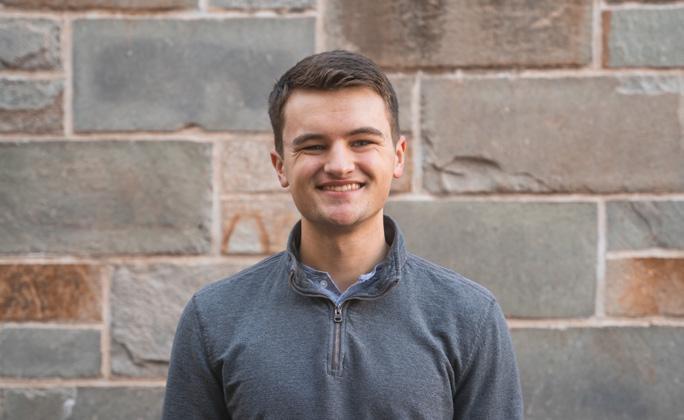
We Zoomers ache for a simpler time. But why? And what does it say about us?
The technology behind vinyl records hasn’t been touched since 1948. Still, these records now outsell CDs for the first time since their sales were measured. Meanwhile, Polaroid’s low-tech, instant-photo cameras have reached a sales renaissance of their own.
2000s-era digital point-and-shoot cameras are also back and ready to flood your social media feed. And to this day, one of the most common gaming devices I see at Boston College is the Wii, an 18-year-old console incapable of HD display (let alone 4K) that has already been succeeded by two full “generations” of Nintendo products.
For the most part, this tech is obsolete. So if we can capture clearer pictures on our smartphones, listen to more music on Spotify, and play better games on the newest Xbox, why is Generation Z so attached to pre-2010s technology?
Older devices are better in some ways. With the right setup, vinyl records sound better than Spotify’s MP3 files. Polaroid cameras deliver convenient, instant printouts that no iPhone can replicate. And whose grandmother doesn’t love “Wii Sports?”
Though these few advantages to older tech persist, I know most (or at least many) vinyl enthusiasts are not buying records for their sound quality. And, though I love “Super Smash Bros. Brawl,” there are definitely better games on my neighbor’s PS5. There’s clearly something else going on.
Here’s the scientific explanation. Consumer behavior researchers would call this fad part of the “consumer identity project.” In a nutshell, this theory dictates that we buy things to give us meaning and “fill the hole” left by the despair of modernity.
In a world where technology keeps getting better, our generation of identity-seekers aims to feel different by embracing the static technology of earlier decades. Ironically, this has led much of Gen Z to flock to the same half-dozen products to harness a false sense of identity.
Soon enough, Gen Z will grow beyond this phase, and Gen Alpha will take our place on the precipice of adulthood. The hamster wheel of nostalgic, identity-seeking consumerism will continue, except it will be dominated by former iPad babies who will reminisce about Cocomelon the same way we reminisce about SpongeBob In other words, we Zoomers are slowly-rusting cogs in the nostalgia market machine—and new cogs are impatiently waiting to take our place.
Please note that I am a massive hypocrite. Point-and-shoot photos adorn both my camera roll and Instagram profile. When I have to give a fun fact at an icebreaker event, I tell people, “I like to collect vinyl records.”
Lastly, playing “Mario Kart Wii” with my roommates gives me an undue sense
of superiority over others. All of that said, how do I reconcile my tech habits with the cold, economic reality behind their renaissance?
Personally, I love the intangible aspects of old tech that modern life has lost in the transition to wireless connectivity, live-service revenue models, and social media apps. These attractive features from the past can show us what’s missing in the present and what we want for our future.
A vinyl record gives you access to a large, ornate, and physically owned album—something a monthly Spotify subscription can’t give you. A Polaroid camera puts totems of good memories right into your hands, and it won’t freak out if your iCloud storage runs out. Playing a Wii game, meanwhile, fills a room with in-person, four-player fun—all without begging you to pay extra for a Battle Pass or in-game currency.
In the modern, superficial, forever-online world that always wants to sell you something, nostalgic tech is a rare breed: it is offline, it is permanent, and it is plain.
Nostalgic devices are not simply reliable machines or shiny baubles in the consumer rat race. Rather, they partly alleviate our ache for physical stability, ownership, and authenticity in a society that begs us to differ. For its part, Gen Z is begging back.
I would like to apologize to my friends at BC. Your vinyls do make you cool, so long as you recognize why you’re attached to them. I know you want to play them more—I want to play mine more too.
Tommy Roche is a columnist for The Heights. He can be reached at thomas.roche@bc.edu.
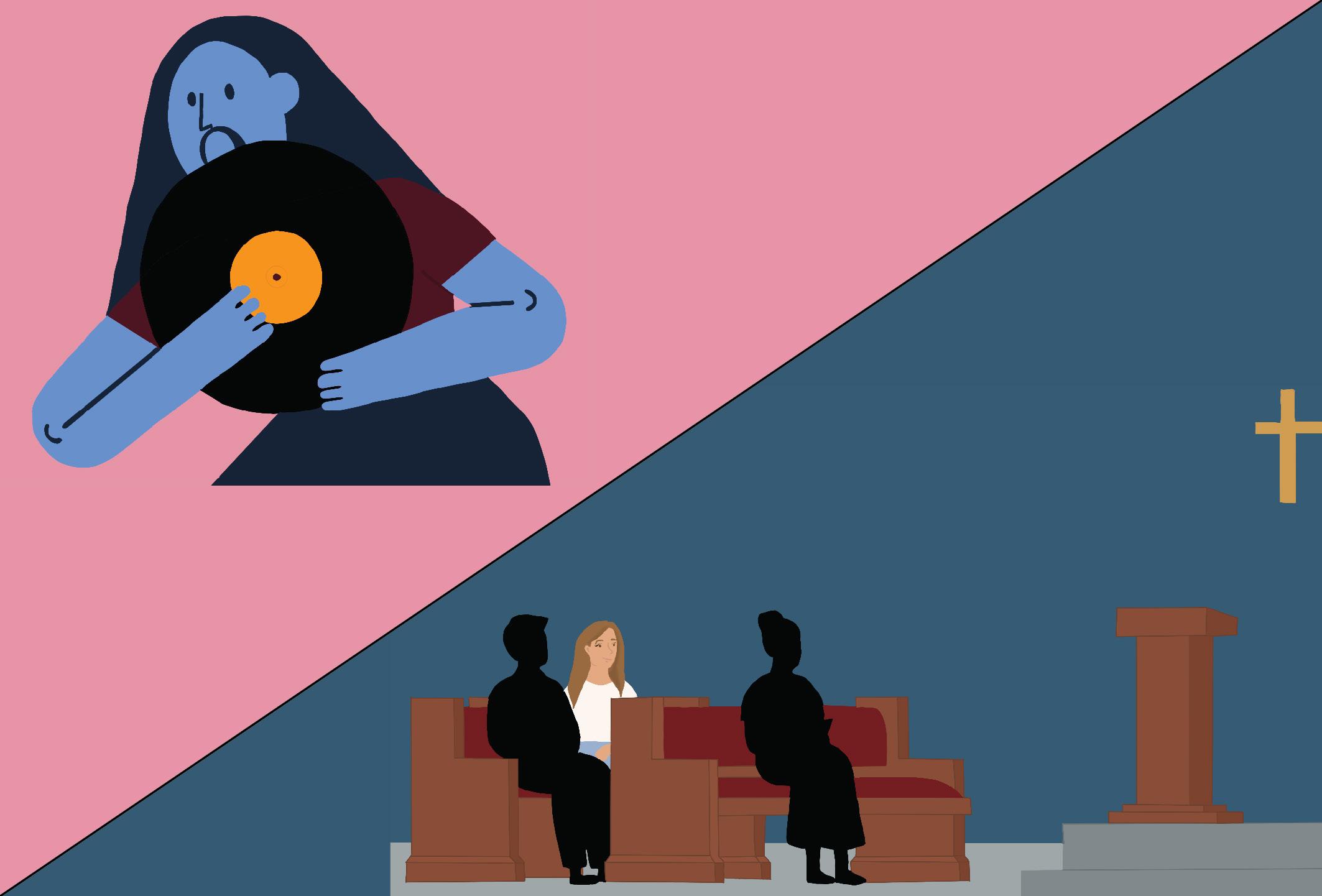

Haven’t you been curious about what draws such an early morning crowd into St. Mary’s Chapel at 8 a.m.? Or why such a well-dressed mob of people flock into St. Ignatius at 5 p.m.? Ever wondered what hallowed secrets are spoken within those walls?
Well, there are no secrets at Sunday Mass—aside from the sacred mysteries, of course.
While Mass is a universal part of the Catholic tradition, it is open to people of all faiths or no faith at all. Whether you’re a Christian, a member of a different religion, or skeptical of faith as a whole, you have to actively and intentionally engage with the unique Jesuit, Catholic spiritual tradition that defines our school to fully grasp the Boston College experience. Attending Mass is one of the best ways to do just that.
It’s kind of like taking a walk through a museum. You are offered a window into the experience and depth of a 2,000-yearold tradition of worship occurring right before your eyes. It’s fascinating. Without
feeling dated and archaic, the experience keeps the ancient tradition alive while meeting the audience where they’re at. Anyone can take away wisdom from the timeless lessons given in the homily and learn from the theological responses to questions of existence, discernment, love, and more.
Especially during the college years, when people our age spend much of their time questioning goals, future plans, and purpose, Mass provides a much needed space for curiosity and discernment to any student willing to sit, listen, and think—even if they disagree with what they hear.
Despite how it may seem, the homily given by the priest is much more like a conversation than a lecture. You absorb what you hear and pay attention to how your soul and mind respond. You might disagree with some of the interpretations of the texts but be captivated by the story told within them. You could find yourself doubting the mystical, extraordinary elements of a parable but also see how its lessons apply to your own life. You might come away understanding a little more about the foundational Jesuit idea of “seeing God in all things” and feel compelled to reflect on the universal truths you’ve experienced.
This practice of deep questioning and seeking out knowledge from views and traditions different from your own is at the very core of Jesuit intellectual tradition. It’s a worthwhile experience for anyone willing to buy into it.

Fall Break
After weeks of late-night study sessions and never-ending exams, we’ve finally arrived at the last stretch of classes before Fall Break. It’s safe to say that this is a much-needed vacation from all of the hard work we’ve been putting in this semester! Whether you’re visiting friends abroad, heading back home, or staying on campus, make the most of this opportunity to step away from your schoolwork and spend time with the people closest to you!

Te Return of Chicken Parm Presser
Upon returning to the Heights earlier this semester, students near and far were left in shock when they realized that the beloved chicken parm presser had been removed from Eagles Nest. After persevering through the start of the semester, we are thrilled to see this fan-favorite returning to the dining hall at long last, filling the void that chicken pesto paninis simply couldn’t. Chicken parm presser, we’re so glad you’re back!
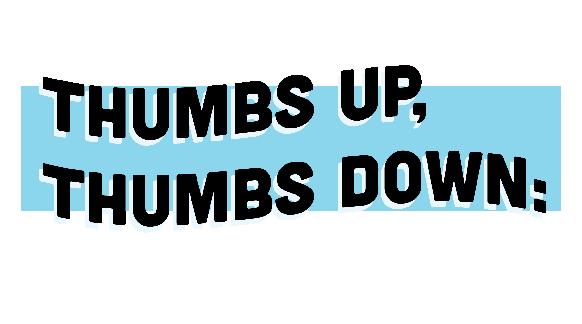

And if you’re confused? The priest is always waiting at the back of the church to send the attendants off into the week with a kind farewell, ready to gladly answer any questions you might have.
Students should take advantage of the peace that Mass promises. It allows you to experience the beautiful tranquility of places like St. Ignatius and St. Mary’s Chapel in action and step away from the rush of daily life to immerse yourself in a historically rich, peaceful, and reflective space.
Not to mention, Mass is often presided over by individuals who have made huge impacts on BC’s culture and history, such as Fr. Tony Penna, S.J., whose position as BC’s hockey chaplain offers him a unique insight into the intersection of sports, school culture, and spirit that can’t be heard anywhere else.
Of course, attending Mass is hardly the only way to interact with the Catholic tradition at BC. It is, however, the backbone of the Catholic worship tradition, and attending it is an effective way to deepen your understanding and appreciation of the faith that underscores our University.
From there, we can each understand a little more about what it means to go forth and “set the world aflame” using our ability to appreciate and learn from perspectives and traditions different from our own.
Skyler Safriet is a columnist for The Heights. She can be reached at skyler.safriet@bc.edu.
Loss After Loss Spirits were high after BC’s incredible win over Western Kentucky during Family Weekend, but a crushing finalquarter loss this weekend left fans feeling like they were watching last season repeat itself. But it hasn’t just been a rough week for football—the men’s soccer, women’s hockey, and volleyball teams all faced losses as well. On the positive side, field hockey was able to take down the University of Virginia’s highly-ranked team. This week might not have been our best, but let’s keep cheering on our teams and hope for some redemption in the games to come!

Trouble With the T
For students looking to spend their free time exploring Boston, the T is essential for getting yourself around town (unless you want to go broke from Uber rides). Connecting campus to the city, students flock to the Green Line every weekend to get to Trader Joe’s for grocery runs and Boston Common for some much-needed reconnections with nature. A recent derailment in Cambridge, however, now has students worried about trusting the T as their main source of transportation. With this event affecting city-wide transportation, let’s hope the MBTA conducts some necessary renovations soon.
Despite their shiny, high-tech exterior, the pervasion of checkout kiosks throughout several of Boston College’s on-campus eateries is creating congestion, discouraging human connection, and damaging these key communal spaces.
After being implemented first at Tully Cafe, then the Chocolate Bar, and most recently at Hillside Cafe, the kiosks have entrenched themselves in the everyday dining experience on campus.
Kiosk ordering systems are popping up all around the United States, expediting transactions at fast food and quick-service establishments. Their ability to reduce costs and increase efficiency is apparent. So why shouldn’t they be implemented on BC’s campus?
“Now every student is pretty much a number,” explained Chloe DeForest, a student employee at Hillside and MCAS ’26. “I feel kind of like a robot just running around, grabbing stuff for people.”
BC is not a corporation accountable for delivering maximal profitability to shareholders. Instead, it must consider what is best for its students in addition to its bottom line. As kiosks fully replace human checkout systems at these campus locations, students lose a social element of the on-campus dining experience.
In a time of rising social isolation—largely due to technology and the widespread reliance on smartphones—forcing students to use yet another screen only adds to the
problem.
“Every class at BC talks about the importance of actually communicating with people,” said a student manager at Hillside. “[Contactless ordering] is so against BC’s mission.”
But the consequences of the kiosks go beyond a change in atmosphere—the machines are causing administrative problems too. Discontent with the contactless-ordering system has caused staffing shortages and low workplace morale, complicating the day-to-day operations of cafes across campus, according to a senior student manager.
“We had a very, very high turnover from the implementation of the kiosks to this semester,” said a senior student manager at Hillside. “Even weeks after the kiosks, people were already saying, ‘Oh, I’m just really stressed and want to cut down on my hours,’ and they just ended up quitting.”
And who could blame them? The anti-social experience of preparing orders from an ever-populating list of virtually submitted demands is just plain lonely.
“The people who got hurt the most with the socialization aspect were the workers,” the student manager said. “You’re so removed.”
Student employees said they were given little notice about the changes to the ordering system and were overwhelmed by the sudden adjustments they had to make to their work habits.
And let’s be clear—kiosks could have been a positive supplement to
BC Dining’s existing infrastructure. Mobile ordering through the GET Mobile app, for example, coexists with traditional checkout registers.
Kiosks could have provided another avenue for ordering, clearing up congestion during peak hours. For students in a hurry, mobile or kiosk ordering could be a convenience, while those with more time could strike up a conversation while ordering. Why limit options for students?
BC Dining realizes this.
“I think feedback in the spring was really targeted around Hillside,” said BC Dining Director Beth Emery. “It’s kind of the senior hangout, and they missed some of that customer interaction. So we’ve tried to build a little bit of that in at the coffee bar, and we have that issue at Chocolate Bar too, and we’ve worked really hard at that.”
While plans for integrating kiosks into full-service dining halls on campus do not yet exist in the short term, Emery mentioned a potential implementation at Addie’s.
BC Dining is not moving away from kiosks. But if it realizes the shortcomings of the system, it should take active steps to improve them— not roll them out further.
The Heights ’ prescription is not to reverse course, but instead to avoid limiting the experience and keep the in-person checkout lanes open.
On-campus dining locations are a key space for communal experience and conversation. Let’s keep them that way.



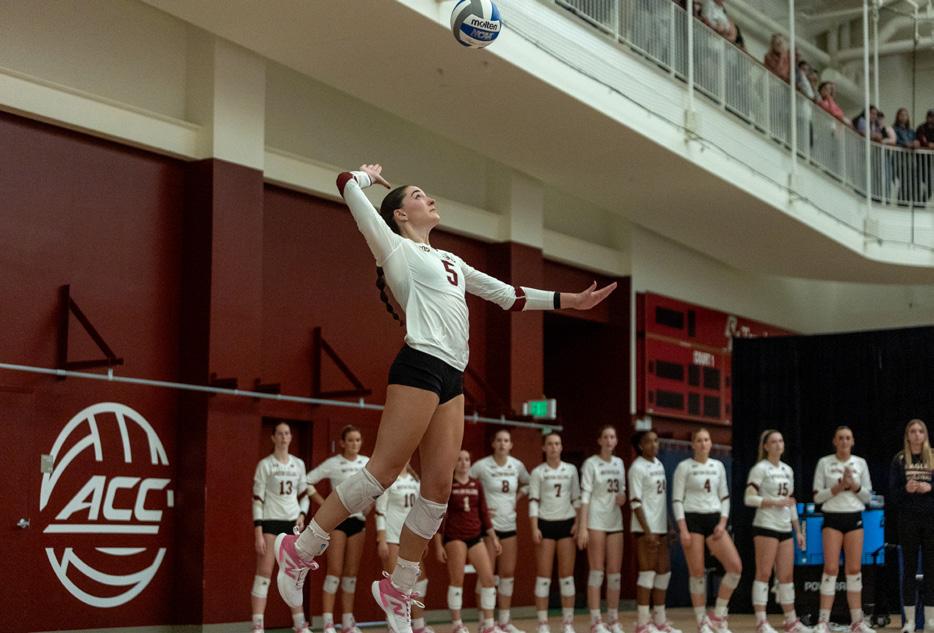
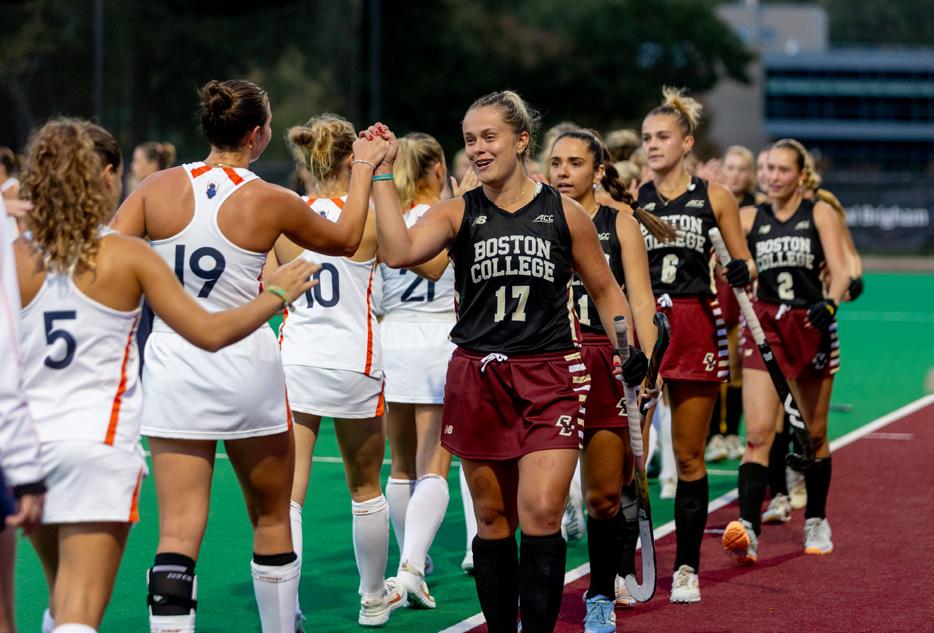
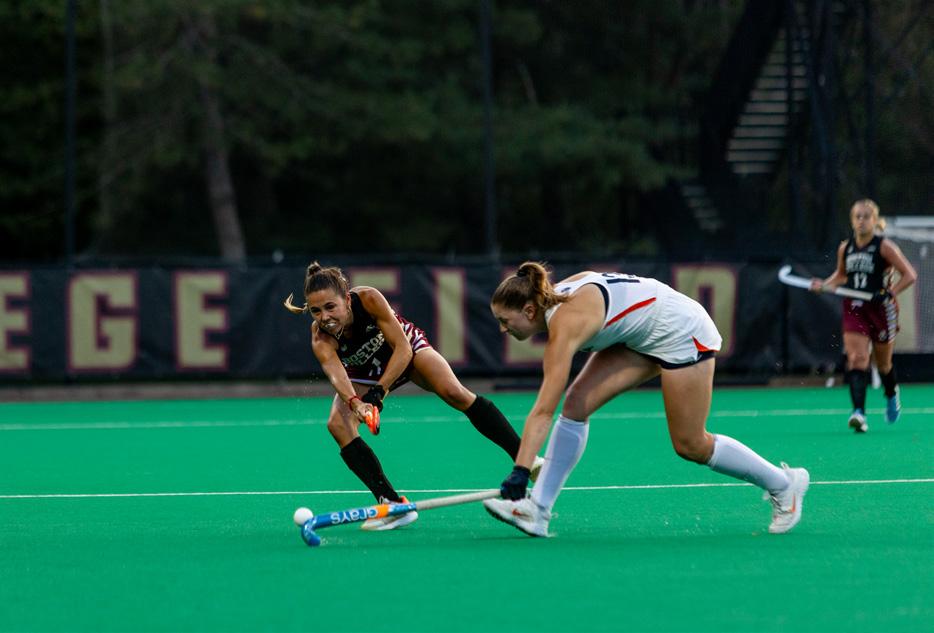

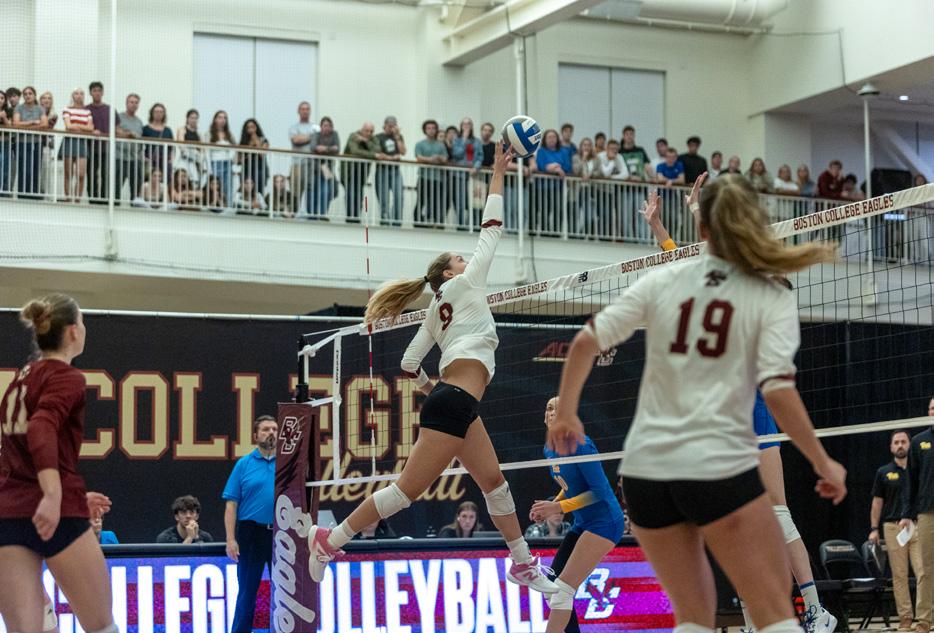
B Y M ADDIE M ULLIGAN Copy Editor
Rising to fame in 2015 with the release of his first studio album Coming Home in 2015, Leon Bridges has long used his music to reminisce on love and his roots. His newest album Leon , released Oct. 4, continues in this endeavor as Bridges refects on his home of Fort Worth, Texas.
Embodying soul in its truest form, Bridges takes us back to the simpler days of childhood as nostalgia rings out through every song.
Self-describing the aptly-named album as his “most personal record,” Leon evokes who Bridges is deep in his soul by focusing on his upbringing.
T e listener is invited to go along with Bridges as he recalls his own life’s journey.
Tat’s What I Love” paints a lyrical image of the early-2000s Fort Worth he grew up in.
“Strawberry, peaches and cream, blackberry soda / Cruisin’ in the Bеnz ‘round the city / Your lips on mine, Texas summеr nights / Feeling the buzz with my brothas,” Bridges croons in his all-too-familiar soulful tone.
Known for his classic R&B
sound that is very much a throwback to the ’60s, Bridges’ niche of soul music is perfectly suited to an album about reminiscing. Its slower, meaningful melodies emulate the singer’s true emotion, precisely what Bridges aims to do in his refections on his upbringing.
While love and childhood are not revolutionary themes, Bridges still manages to create a very solid album. Letting his soul prowess shine, Bridges overcomes the fairly basic nature of the album’s themes by creating quite touching tunes.
Such is the case with “Laredo.”
Although it is another simple tribute to his memories of home, Bridges shapes an entrancing chorus through repetitive infections and a steady undercurrent of drums.
“Play me something downtempo / Low-key and rocksteady / Body hittin’ like Kimbo / Fallin’ for you like confetti,” Bridges sings.
Many artists will refect upon what has infuenced them through song, but Bridges manages to do something special in his natural way of song-making. Efortlessly groovy, “Laredo” makes the straightforward topic of childhood compelling by layering bass on shakers, creating a melody you can’t help but sway to.
“Panther City” f nds Bridges
singing about his summertimes specifcally. Admittedly less irresistible than “Laredo,” the addition of a third nostalgia-based song makes clear what Bridges is attempting to do with Leon
Transitioning from nostalgia, “Ain’t Got Nothing On You” is an exceedingly heartfelt song about his love for a special person in his life . Known for his songs about afection such as “Beyond” and “River,” Bridges goes back to his roots not only by reminiscing about childhood but also in his topic choice.
Bridges has a knack for writing love songs, with the listener often wishing they were the “you” he serenades. Tugging at the heartstrings, Bridges’ soulful tone elucidates the warmth and adoration he wants to convey in his love ballads.
“Like the sound of a song on my old guitar laying down some two-chord truth / Yeah, it’s true / Baby, they ain’t got nothing on you,” Bridges sings in “Ain’t Got Nothing On You.”
Ensuring the listener feels the love he feels, Bridges is unique in how remarkable he can make a simple love song. Te epitome of this comes with “Ivy,” the third to last song on Leon.
Profound in its layered back-
ground vocals and cycling melody, Bridges transcends the average love song to create a touching listening experience. While sounding less like the R&B he is known for, Bridges’ vocals still manage to make “Ivy” soulful.
“Life is evergreen when you’re next to me / Heals like a remedy, feels in the chest of me / All I really need is you / All I really need is you,” Bridges sings.
With an immensely satisfying sound to go along with the lyrics, “Ivy” is a fantastic example of Bridges’ musical genius in how he bends genres to ft into classic soul.
Finishing of the album, Bridges tacks on “Ghetto Honeybee,” another soulful love ballad, before ending with “God Loves Everyone,” a more mellow and bluesy song. While not harping on the album’s theme of nostalgia, Bridges leaves
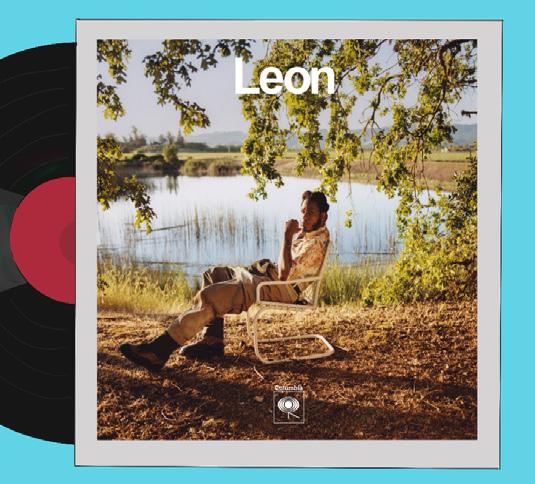
the listener with a message of equality under God’s love.
Bridges is known outside of music for his activism in co-founding Te Big Good, a philanthropic organization based in his home of Fort Worth.
Bridges also wrote the song “Sweeter” as a call for the end of racism in the wake of George Floyd’s murder.
“Old men and the young and the strange / School kid looking out at the rain / Cops on the beat and the crooks in the cage / Just the same,” Bridges sings.
Delivering a musical ode to his childhood, to nostalgia, and to love, Bridges creates a masterclass of soul in Leon
Despite the simplicity of his themes, Bridges’ songwriting skills create a poignant tribute to his home. n
vulnerability.
For The Heights
Known for his most popular song “Till Forever Falls Apart,” and as Billie Eilish’s talented brother, FINNEAS has recently captivated listeners with his new album, For Cryin’ Out Loud!
As both a singer-songwriter and producer, he has made a significant impact in the music industry, carving out his own identity while contributing to his sister’s groundbreaking sound.
His third studio album For Cryin’ Out Loud! features 10 tracks that delve into themes of love, heartbreak, and self-discovery, all wrapped in a sound that resonates with both intensity and
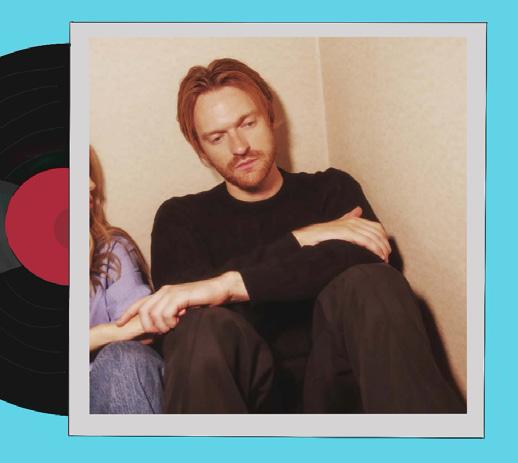
The tone of the album shifts from introspective ballads to energetic anthems, capturing the complexities of relationships and the struggles of love. Each song unfolds a story that feels both intimate and relatable.
Musically, For Cryin’ Out Loud! draws parallels to FINNEAS’ previous work while also introducing new sonic elements.
The production mirrors the epic soundscapes heard in his work on Eilish’s music, with grand choruses that evoke a cathartic experience.
The album builds up to climactic moments, where listeners feel as though they are fully immersed in an emotional journey.
The album opens with “Starf— er,” a song with a soft piano melody that casually builds up, creating an engaging soundscape that sets the stage for what is to come.
Lyrically, FINNEAS explores the theme of relationships in the context of fame and superficiality, addressing a former lover who used their relationship for personal gain and status.
“You starf—er, I loved you / Against my better judgment,” FINNEAS sings.
The album’s rhythm completely changes with the next track, “What’s It Gonna Take To Break Your Heart?” The track is a poignant exploration of unreciprocated feelings and the uncertainty that accompanies a fragile relationship.
With the song’s layered synths, punchy percussion, and heartfelt lyrics, FINNEAS candidly questions whether his love will leave a lasting impact on his significant other.
The song’s introspective chorus emphasizes a longing for clarity and connection, while the production gradually builds emotional depth, allowing listeners to feel the
weight of his vulnerability.
“If you only knew the way I pray for you, there’s nothing I can do / If you only knew I don’t mind making room, I just want more of you,” FINNEAS sings.
“Family Feud” is a heartfelt exploration of familial bonds and the complexities of growing up. The lyrics reflect on nostalgia and the bittersweet moments shared between siblings, particularly highlighting adulthood’s challenges.
In this track, FINNEAS reminisces about shared experiences and the weight of expectations, acknowledging that despite the distance that might grow between siblings, their connection remains.
“Part of me is part of you / Just a different shade of blue,” FINNEAS sings, emphasizing the enduring nature of family ties even amid conflicts and misunderstandings.
Musically, the song juxtaposes a laid-back, almost whimsical sound with poignant lyrics.
This combination of introspection and relatable storytelling showcases FINNEAS’ growth as an artist, proving he can evoke deep emotions while still maintaining an
engaging musicality.
The upbeat tune “Lotus Eater” finishes the album on a high note, encapsulating carefree moments amid life’s complexities. The track stands out with its infectious energy and clever lyrical play.
In it, FINNEAS reflects on the fleeting nature of relationships and the joy of living in the moment. The chorus is an anthem of youthful fun, capturing that exhilarating feeling of love and desire.
“Grab my wrist ’til your knuckles are white / It’s a brand-new kiss in the same old light,” he sings.
As the final notes of “Lotus Eater” fade out, listeners are left with a sense of resolution and reflection. FINNEAS’ ability to blend emotional depth with catchy hooks shines through, showcasing his growth as an artist.
With For Cryin’ Out Loud !, FINNEAS uncovers new emotional depths while staying true to the vulnerability and introspection that define his music.
There’s always a raw honesty in his work—a desire to connect deeply with listeners through personal themes. n
B Y M ARIA B EATRIZ S ALDANHA Heights Sta ff
The long-awaited Joker: Folie à Deux disappoints fans of comic books, as well as fans of musicals. Despite returning Academy Award-winning actor Joaquin Phoenix as the main character alongside pop diva Lady Gaga, the sequel to Todd Phillips’ record-breaking 2019 flm fails to live up to its expectations.
Joker 2 follows Arthur Fleck (Phoenix) as his mental state deteriorates while confned in Arkham State Hospital. Tere, he meets Lee Quinzel (Gaga), more popularly known as Harley Quinn, and the two quickly develop a relationship founded on infatuation.
Most of the scenes in the flm outside of the mental facility take place in a courtroom, where Fleck is on trial for his crimes. Hearings and debates unfold over the course of the flm’s 138-minute runtime, with the
intention of deciding the aspiring comedian-turned-murderer’s fate.
The movie, which premiered in theaters on Oct. 4, deals with themes similar to its predecessor, with a focus on mental illness, its consequential violence, and the question of morality—or lack thereof—surrounding it. Unlike Joker (2019), Phillips’ latest film lacks the “it” factor that pulls the audience into the dark universe of the antihero. By having the characters sing their feelings, the movie attempts to innovate, but ultimately falls short. Instead of adding a layer of emotional depth, the musical performances feel out of place, distracting viewers from the messages the characters are trying to convey.
Throughout the film, Phoenix and Gaga cover multiple songs, mainly jazz hits (“For Once in My Life” and “Bewitched”) and musical theater tracks (“If My Friends Could See Me Now” from Sweet Charity
and “That’s Entertainment” from Te Band Wagon). Most notably, “Folie à Deux” was written and performed by Gaga. Te song plays over one of the movie’s few romantic scenes, where Joker and Quinn carelessly tango the night away on a rooftop.
A cartoon short titled “Me and My Shadow” sets the scene before Phoenix shows up on screen. Te animation, created by French director Sylvain Chomet in a style reminiscent of Looney Tunes, features Fleck’s sinister shadow as he gets ready to go on a live TV show. The scene mirrors a key moment of the first film, where the clown mercilessly murders a TV host on air.
In the cartoon, Fleck’s shadow separates from his body right before committing the crime, hinting at the central question of the second flm: Is the man on trial guilty for his actions, or is the Joker a separate personality within Fleck?
One would expect the movie to try to engage the audience on its quest for answers, but that is not the case. Despite Phoenix and Gaga’s commendable performances and notable on-screen chemistry, the overall plot fell fat. Te singer’s portrayal of Quinzel showed potential, but her depth was not fully explored. Quinzel seemed to exist merely to make the audience question if anyone could be as deranged as the Joker, rather than contribute meaningfully to the story.
In terms of cinematography, Phillips’ work is worthy of praise. His

creative vision shines through in key moments throughout the flm, such as in the interview scenes with Fleck. Tese sequences are cleverly shown from two perspectives: the standard face-to-face conversation, and the tapes recorded by psychiatrists and investigators, which add a retro feel to the visuals.
Joker: Folie à Deux wasn’t dark enough to be a psychological thriller, romantic enough for a romance, or funny enough for a comedy. All it proved was that the original Joker would have been better of without a sequel. n


Boston College football’s o ffense collapsed in the second half as Virginia came back from a 14–6 deficit, took the lead, and ultimately defeated the Eagles 24–14.
Football, from A1
BC kept up its offensive dominance as the first quarter wound down.
Castellanos continued to let it fly, connecting with Reed Harris for a 27-yard completion to start the drive.
The Eagles continued to drive as the second quarter began, taking a 14–0 advantage courtesy of a 29-yard touchdown pass from Castellanos to Morales.
“Doesn’t matter,” O’Brien said of the Eagles’ fast start to the game. “Doesn’t matter. Doesn’t matter. You gotta play 60 minutes, it’s not a 30-minute game.”
That was the last time the Eagles scored.
BC elected to defer the kickoff after winning the coin toss prior to the game, and as the clock wound down on the first half, BC looked to take full advantage.
Turbo Richard propelled the Eagles downfield via three rushes totalling 31 yards, but BC failed to capitalize and punted to the Cavaliers who began to mount their comeback.
The Eagles appeared to be doing everything they could to help Virginia bring the game within one score as the second quarter wound down.
A targeting penalty on Khari Johnson that resulted in his ejection and an illegal-handsto-the-face penalty on Sedarius McConnell helped the Cavaliers make their way into field goal range, making it a 14–6 game at the half.
“Yeah, I think it played into the loss,” Donovan Ezeiruaku said, regarding penalties and undisciplined play. “It was pretty significant, obviously coach O’Brien preaches playing disciplined football, penalty-free football, and those are things that
we can control on the field.”
After the Eagles failed to extend their lead in the opening drive of the second half, Virginia launched a 7:42 drive that ended on the Eagles’ two-yard line.
Anthony Colandrea and the Cavaliers went for it on 4thand-2, but KP Price broke up the pass to force a turnover on downs and avoid a Virginia touchdown.
BC ended up punting the ball right back to the Cavaliers, though, and they picked up where they left off.
The Eagles held strong in the red zone, though, and contained Virginia to a field goal to make it a 14–9 game with 13:29 left in the fourth quarter.
On the next BC drive, disaster struck for the Eagles, and everything began to spiral.
Castellanos threw an interception, and Virginia made quick work of the Eagles’ defense, needing just two plays for Colandrea
to find Malachi Fields in the end zone for a touchdown.
The Cavaliers converted on the two-point conversion and established a 17–14 advantage with 10:39 left in the game. On the next BC drive, Castellanos fumbled, and the ball was promptly picked up by Jonas Sanker, who took it to the house for a touchdown.
Will Bettridge knocked down the PAT, and the Eagles found themselves on their heels with 6:02 left on the clock.
And with 3:14 left on the clock, Castellanos threw another interception to put any hopes of the Eagles advancing to 5–1 on the season to rest.
“We have to look in the mirror,” O’Brien said. “Everybody in the program has to self-assess, coaches and players. We all have to look and see what we can do to be better, because we’re a lot better than what we showed today.” n

BY GRAHAM DIETZ Alumni Director
Without a stammer in his voice, Bill O’Brien told it as it was. He did not lie. He did not try to hide it. He did not pretend like the outcome was something it was not. Boston College football had blown away its Week 5 matchup at unanswered points. Castellanos finished the game with two interceptions, a fumble, and negative rushing yards. Turnovers, messy penalties, lack of a run game, and weak third-down efort all contributed to BC’s meltdown. Here are three observations from the loss.
or a mistaken desire to prove his pocket-passing abilities, Castellanos is stuck in purgatory, and it’s costing the whole team. Tis Saturday, Castellanos fnished in the negatives for rushing yards for the frst time in his career (-9).
On 3rd-and-8 with 6:18 to go, down 17–14, Castellanos surveyed the feld and could not fnd a man open. He ditched the pocket and ran to his left, only to fnd himself surrounded by ve Cavaliers. He had room to get out of bounds and protect the ball, but he attempted the hero throw instead.
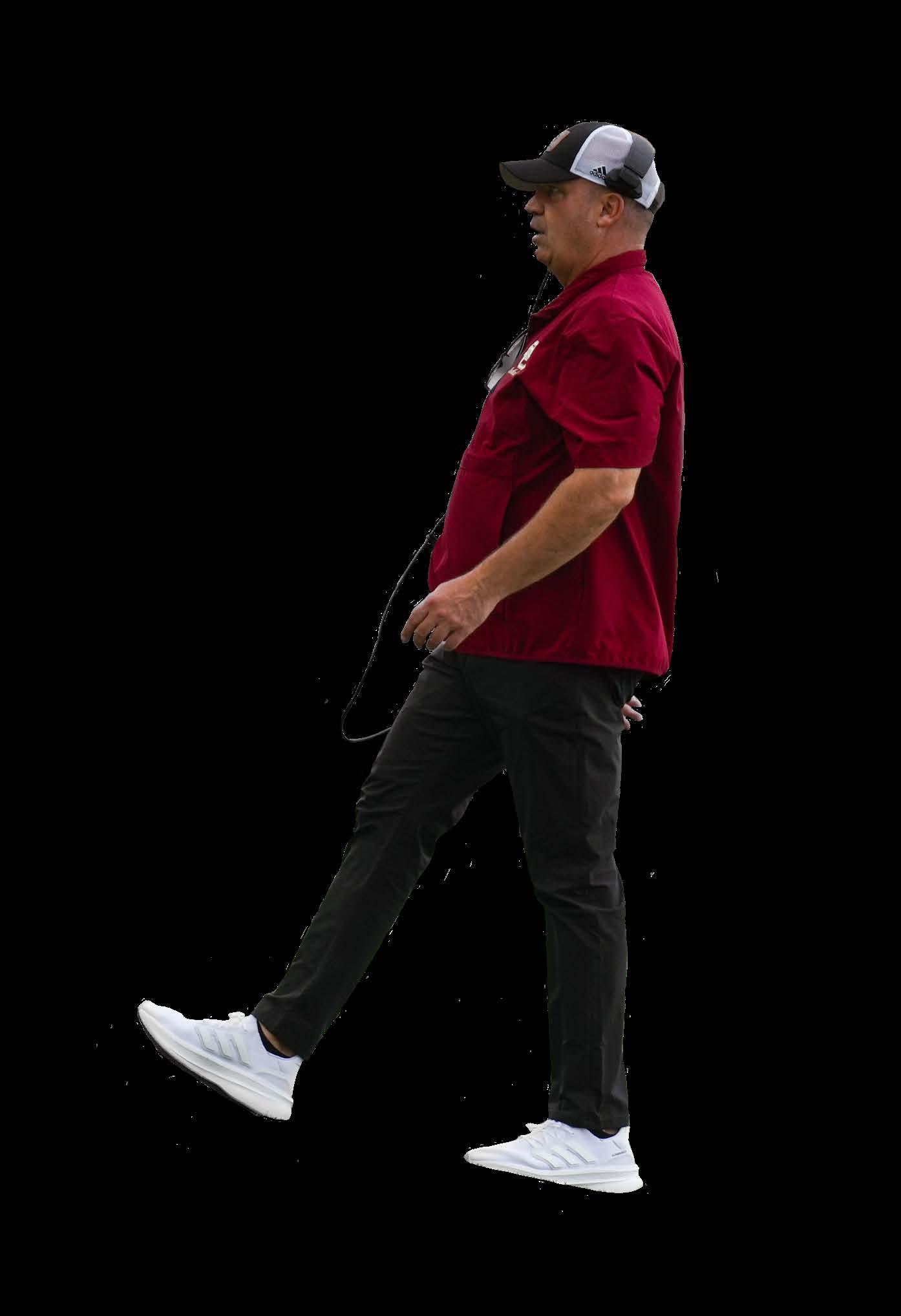
Castellanos lost control of the ball, which he fung over his back shoulder in Jameis Winston Rose-Bowl fashion, and Virginia scooped and scored to make it 24–14, a brutal way to put the nail in the n.
On the Eagles’ next ofensive drive, with plenty of time left to make a comeback, Castellanos faced two consecutive one-yard downs and was unable to convert either, throwing back-to-back incompletions.
He danced around the pocket looking for an unmarked receiver, but once again, there was no open room except for the relatively empty field ahead.
Te shift away from the run game has proven to be a disaster for the Eagles when it comes to playing the full 60 minutes. Apart from Duquesne, the passing scheme has not held up for an entire matchup thus far.
Te Eagles fnished with 65 rushing yards total on just 29 attempts, down cantly from the season-opening win at then-No. 10 Florida State, in which they accumulated 263 yards, 73 for Castellanos alone, on 52 attempts.
Te stats never lie, and there are some key instances where trusting his scrambling ability would have worked more efectively than forcing the ball
through the air. That is not asking for 10-to-15-yard gains every time Castellanos runs the ball, either. But four-to-fve-yard gains, which should be manageable to attain, are better than an incomplete pass.
Penalty Woes and Lack of Discipline
Te Eagles came into their second ACC matchup of the season ranked second in the nation in average penalties a game (3.4). Tey accumulated fve in the frst half alone, including a targeting call which disqualifed Khari Johnson with 1:40 left in the half.
“We’ve got to understand the rule,” O’Brien said. “If you hit with the top of your head, it doesn’t matter where you hit him … It’s a safety issue. We have to learn to look the tackle in. I try to explain that to our players. I don’t think I’m doing a good enough job.”
BC fnished the contest with eight penalties for 85 yards compared with the Cavaliers’ fve for 28 yards, and the Johnson occurrence was not the most upsetting one.
One drive after fumbling the ball in the fourth quarter to give Virginia its two-score cushion, Castellanos did not snap the ball in time, resulting in a 1stand-15 and eventually a three-and-out.
On BC’s next ofensive drive— which turned out to be its last— the Eagles needed to take a timeout because there were only 10 players on the feld with 3:54 to go. After completing two passes for a gain of 20 yards, Castellanos had a complete miscommunication with Jerand Bradley downfeld, seemingly forgetting the receiver’s route, and fred the ball right into the hands of Virginia’s corner.
Out of frustration, Castellanos decided to try and clobber the defender after he had already stepped out of bounds, which resulted in an
unnecessary roughness penalty. Poor execution led to poor body language as Castellanos threw up his hands in disgust.
“It was pretty signifcant,” Donovan Ezeiruaku said. “Coach O’Brien preaches playing disciplined, penalty-free football and those are things we can control.”
Much of the second half revolved around the ofense’s errors and total collapse, but the defense’s ability to stop third-down attempts was lacking in the fnal two quarters as well.
The Cavaliers converted seven of its 16 third-down attempts, a few of them from more than 10 yards.
On 3rd-and-13 with 9:15 to go in the third quarter, Virginia quarterback Anthony Colandrea completed a short pass to Malachi Fields which the wideout brought up the feld for a 19-yard frst down.
Five plays later, Colandrea found Tyler Neville for another 19-yard pickup on 3rd-and-9. While the drive resulted in a turnover on downs, it brought the ball all the way into BC’s endzone, which put the Virginia ofense in a tricky situation.
Just as the third quarter was ending, Colandrea picked up another third-down conversion on 3rd-and-10 with a 17-yard pass to Neville. Te drive resulted in a feld goal for the Cavaliers to inch them closer to the lead.
O’Brien did not ofer any insight into the breakdown of those defensive alignments because he needed to watch flm frst, but he still described the problem as inexcusable.
“Tank God we got 12 days before our next game,” O’Brien said. “Maybe we can get some things corrected.” n GRAPHIC BY BROOKE GHALY / HEIGHTS EDITOR
But the Badgers broke through 11 seconds later when Lacey Eden slammed home a goal off a rebound.
The Badgers continued to generate consistent offensive pressure and gave the Eagles little time and space. The Eagles found themselves shorthanded with a minute remaining in the first period after a delay of game penalty from Sammy Taber. BC killed the first penalty and escaped the first period down one goal. But the shot count after the first period was 21–6, favoring the Badgers.

The second period is when things really started to unravel for BC. The Eagles found themselves shorthanded once again after an interference call against Alanna Devlin. This time, the Badgers capitalized on the advantage.
Caroline Harvey ripped a shot that went top shelf to extend Wisconsin’s lead.
The game continued to spiral for the Eagles as the Badgers scored two more goals in three minutes. A passing play between Wisconsin’s Katie Kotlowski, Casey O’Brien, and Kirsten Simms led to a goal on a 2-on-1 that gave the Badgers a 5–0 lead.
They were able to extend the lead to six before the end of the second period with a goal from
O’Brien.
“There were too many turnovers in the neutral zone,” Crowley said. “If we put one in early, I think it changes the game a little bit. Once you get down there it’s hard to keep going, but I was happy with the way we battled and continued to fight through the 60 minutes. We just have to make quicker plays.”
The third period saw much of the same dominance from the Badgers, and there was some chippiness that resulted in penalties on both teams.
The Badgers added a final goal from Sarah Wozniewicz after a defensive turnover in front of the Eagles’ net gave her an open look. n
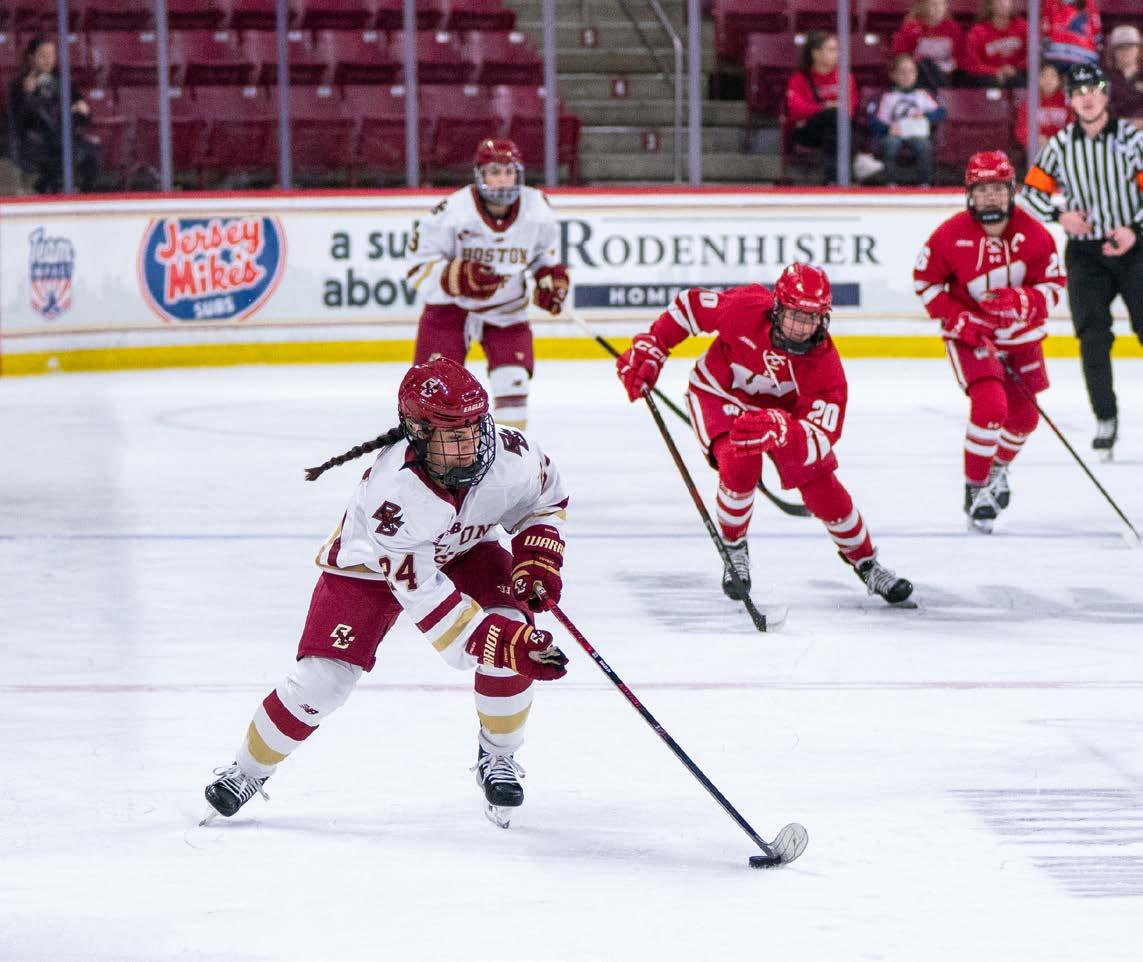
BY CHARLIE DAVIDOW Heights Staff
With just over 2:30 left to play in the fourth quarter, Boston College feld hockey lined up for its 10th corner penalty opportunity, looking to f nally put the ball behind the reigning Atlantic 10 goalkeeper of the year, Myrte van Herwijnen.
Much like their previous nine attempts, however, the No. 10 Eagles failed to capitalize, and No. 19 Massachusetts held on to its one-goal lead until time expired.
Missed opportunities cost the Eagles a chance at a seventh consecutive win in a game in which they heavily out-shot their opponent.
“You can’t have 10 corners and not score any and expect to win a game,” BC head coach Kelly Doton said following the game. “We got to be able to put the ball in the back of the cage … We didn’t do that.”
BC (8–3, 3–0 Atlantic Coast) lost 1–0 on the road to UMass (9–3, 2–0 Atlantic 10) in a ranked matchup Sunday.
Te Minutewomen controlled the pace of the game early, playing a cleaner game and outshooting the Eagles in the frst.
Just over 12 minutes into the quarter, UMass’ Dempsey Camp-
bell tallied the game’s only goal of a strange bounce that saw the ball pop up several feet in the air before falling in behind BC goaltender Charlotte Kramer.
“We didn’t show up in the frst half,” Doton said. “The energy wasn’t there, and we were making silly mistakes, and it cost us.”
As a choppy frst half that included two overturned BC goals came to a close, an errant pass struck BC’s Yani Zhong in the head. Doton said postgame that Zhong avoided a serious injury.
Te Eagles began to fnd their game in the second half, putting heavy pressure on the Minutewomen’s defense and generating chances.
“We started to play with energy, we were attacking, we got corners, and we were getting the ball inside the circle,” Doton said.
Te Eagles outshot UMass 6–2 in the second half, putting a total of 10 on goal in the game, compared to UMass’ three.
But despite their offensive opportunities, the Eagles couldn’t fnd the back of the cage.
Tis was thanks in large part to the performance of van Herwijnen, as she stood on her head, making 10 saves.
Te third quarter featured two more BC corner chances, the second of which saw van Herwijnen make a diving save on BC’s mid-
felder Peyton Hale.
Hale received the game’s lone yellow card with three seconds remaining in the third, leaving the Eagles without both Hale and Zhong for the frst fve minutes of the fourth quarter.
T e lack of elite goal-scorers was not what the Eagles needed as they pushed to tie the game, and it showed, as the frst fve minutes of the fourth saw no real scoring chances for the Eagles.
With Hale back on the field, the Eagles had four more corner penalties and fve more shots in the
fnal 10 minutes, but were unable to erase the one-goal defcit.
“Unfortunately, the ball just wasn’t going to go in, but [the chances] were there,” Doton said.
It was once again a tale of two halves for the Eagles, who have been trying to improve upon their slow starts.
Te frst half we didn’t come out and play well,” Doton said. “At the end of the day, you’ve got to go from the starting whistle. Great teams know that, and we’ve got to use this as a lesson going forward.” n
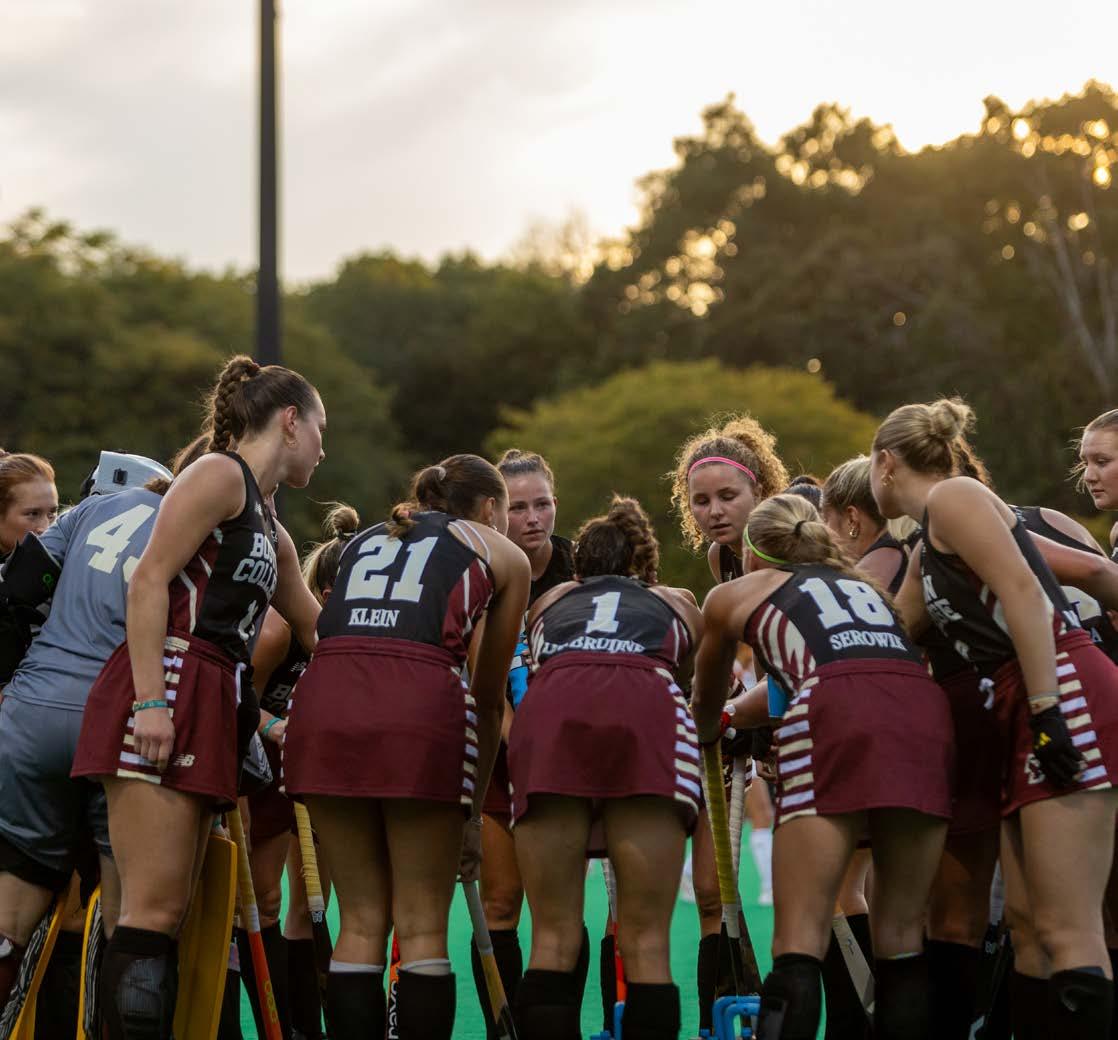
BY EMILY ROBERGE Assoc. Sports Editor
The last time Boston College women’s soccer defeated Clemson was in 2018 when the then-No. 11 Eagles defeated the Tigers 2–1.
On Sunday afternoon, the winless streak continued. BC fell yet again to Clemson 2–0, giving the Tigers their first conference win of 2024 after going 0–4 in previous ACC matchups against Virginia Tech, then-No. 3 Duke, No. 7 Florida State, and Pittsburgh.
The Eagles (10–3–1, 2–2–1 Atlantic Coast) failed to convert any of their 13 corner kicks into scoring opportunities on net against Clemson (5–5–2, 1–4–0), logging just four shots on goal in the matchup.
Every chance of a possible BC scoring opportunity, the Tigers shut them down.
After a back-and-forth battle of possession in the first 15 minutes of the opening half, Clemson finally took control of the ball and never looked back.
Off a Tigers’ corner kick, Clemson’s Mackenzie Duff launched the ball into the top left of the Eagles’ net and snuck it over the hands of Wiebke Willebrandt. Tasked with an opportunity to
respond to Clemson’s goal, BC couldn’t do so for the remaining minutes of the game.
While BC’s offense failed to make plays after Clemson’s goal, Willebrandt held BC’s defense together with save after save.
Less than two minutes after the Tigers’ goal, Willebrandt came up big. Following a shot from Jenna Tobia on the bottom center of the net, Willebrandt jumped for the ball, grabbing it and eliminating any possibility of a possible Clemson deflection shot.
But Willebrandt was not done quite yet. With 3:43 left to play in the first half, off another Duff shot, BC’s goalkeeper swiftly punched the ball out of its path toward the net, which resulted in a Clemson corner kick.
And while the Tigers ultimately couldn’t produce another goal while on the attack, they ended the first half having dominated possession.
Despite four corner opportunities for BC, the Eagles were unable to put any of their shots in the back of Clemson’s net. The Tigers registered nine shots in the first half, while BC got three off.
The Eagles needed a change going into the half. Instead, it didn’t take long for the Tigers to bring another shot home and take the game further out of BC’s reach.
Just 55 seconds into the second frame, Clemson delivered yet again. After Tobia’s shot was saved by Willebrandt, Kendall Bodak corralled the rebound as she ran toward BC’s net.
Nailing the ball with a right-footed shot, Bodak sent the ball into the bottom left of BC’s net, silencing any chance at an
immediate BC comeback.
As the clock ticked down, so did BC’s chances at producing a goal. Despite tallying nine corners in the second frame compared to three from Clemson, BC was unable to convert any into a goal.
What was more telling was the Eagles’ inability to produce shots on net. Going into the game, BC ranked top-20 in the country in goal-scoring, but their matchup against the Tigers told the opposite story.
In 50 minutes of play, Clemson registered 19 shots on net while BC only delivered nine, ending in a Tiger shutout and calling into question BC’s offensive production. n
